In the 18th and 19th centuries the Dowleys of Ballyknock were the biggest single family of Dowleys in the Carrick-on-Suir area. The Ballyknock farm is located about 5 km south west of Carrick-on-Suir at the foothills of the Comeragh mountains in Co. Waterford. approached via the Seskin Rd or via the Coolnamuck Rd and Rathgormuck Rd. Originally there was only one farm but this was subsequently divided to cater for the expanding family members.
While the two farms are currently (2011) occupied by the Dowling and O’Brien families, they are both descendants of the “Ballyknock” Dowleys. The great number of Ballyknock descendants who entered religious orders has contributed to the disappearance of the Dowley name from both the Ballyknock and Aughnabrone farms over time.
Due to the large number of clergy in the Ballyknock Dowley families, a small oratory was maintained at the house where mass could be celebrated by the visiting priests.
A letter from Fr. Michael Dowley to his nephew Michael in the USA dated 1947, outlines the history of the Ballyknock Dowleys. At the time of writing, Fr. Michael was 74 years of age and his memories may not be completely reliable as a number of small errors have been confirmed.
According to Fr. Michael, the first record of a Dowley in his family was a Fr. John Dowley who was a professor at Louvain. The same letter suggests that the first Dowley in Ballyknock was Maurice (1695-1778).

The Dowley farmhouse at Ballyknock (photo 2011)

The small Oratory at Ballyknock
Assuming that Fr. Michael is correct, the Tinvane Dowleys pre-dated the Ballyknock Dowleys by some 100 years. However, the ancestors of both families must have pre-dated the existence of both Tinvane and Ballyknock and these ancestors may well have been related although there is no data to confirm this at present.
The first three generations of Ballyknock Dowleys
The first Ballyknock Dowley for which there is any information is Maurice Dowley (1695-1778). According to Fr. Michael’s letter, Maurice had a brother, Fr. Michael Dowley OSF (1725-1778), who was a Franciscan priest and the Guardian of the Friary in Carrick-beg. However, as he was 30 years younger than the first Maurice it is assumed that he must be the brother of the second Maurice.
The headstone in the Friary grave yard Carrick-Beg showing Michael Dowley O.S.F.
The existence of a second Maurice Dowley of Ballyknock is confirmed by Fr. Michael Dowley’s letter of 1947. However, it is strange that there are no dates for the second Maurice. The first Maurice may have been married to an Alice Purcell while the second Maurice appears to have married an Honora or Nora Corbet of Waterford.
The second Maurice had 9 children, 6 boys and 3 girls. The 3 girls, Honora, Joanna and Ellen, all married Waterford men and lived relatively near to Ballyknock. Of the 6 boys, Philip and Thimothy became ordained priests. The eldest boy, Thomas and Maurice remained farmers in Ballyknock while John moved to a farm in Whitestown near Curraghmore. Michael moved to the town of Carrick-on-Suir where he became a successful business man.
A very interesting, if somewhat inaccurate, account of the history of the Ballyknock Dowleys has been compiled by Mrs Betty Wilkinson of Australia who was a great-grand daughter of Michael Dowley and Mary Kavanagh. Her mother Mary (May) Dowley moved to Australia where she married a Mr. Smith. Betty Wilkinson (nee Smith) was the outcome of this marriage and as a result she was an Australian of Irish descent who probably had a romantic attachment to her Irish heritage and the Ballyknock Dowley family. As she spent most of her life in Australia, her confusion of the different Carrick Dowleys is totally understandable and this could possibly be embellished by the normal Dowley “baiting” of gullible strangers. Her very readable account can be found at the end of this section.
The following outlines the relationships between the first three generations of the Ballyknock Dowleys.
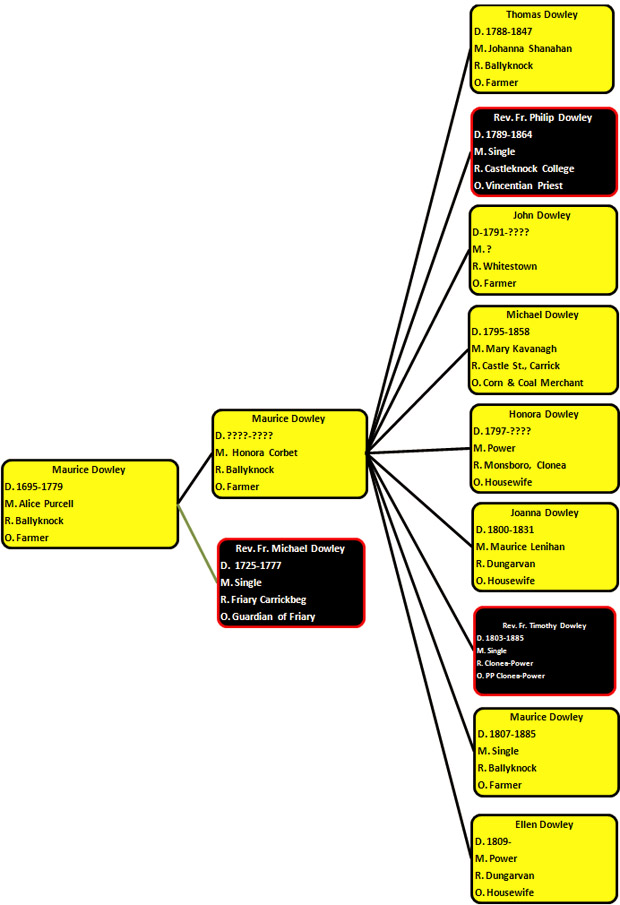
The First Three Generations of Ballyknock Dowleys
Thomas Dowley (1788-1847): Thomas was the eldest of Maurice’s children and as such inherited the farm at Ballyknock. He married Johannah Shanahan of Kilmacthomas and they had 8 children, Honora, Maurice, John, Mary, Ellen, Johanna and Alice. He built the new house at Ballyknock which was completed in 1847. The above Johannah Shanahan was a member of the same Shanahan family that were connected to the Flahavans, Walshs and Tinvane Dowleys (see Kilmacthomas connections).
John Dowley (1791-1868): It appears that John went into a farm in Whitestown East near the western gate into Curraghmore. While there is no record of a wife, he must have married as he had at least three children, Thomas, John and Johanna.
Rev. Fr. Philip Dowley (1789-1864): Following a period as Dean of Maynooth, Fr. Philip Dowley was appointed vice-president of the College on 25th of June 1834. He resigned on 27th of June 1834, presumably to take up his appointment as head of the Vincentians in Ireland. Apparently it was desirable if not essential at that time to have a high ranking Irish cleric as head of any new religious order being established in Ireland. As a result Fr. Dowley was persuaded to take up the position of head of the Vincentians in Ireland. The Rev. John McCann, who came from a wealthy family in Drogheda, supplied the funds to purchase Castleknock College for the Congregation of the Missions or Vincentians in 1835. From 1835 to 1860 it was known as St. Vincent’s Ecclesiastical Seminary when the students consisted of some 50% clerical students studing for the priesthood and the remaider being lay students. Among the early students were five Ballyknock Dowleys, Maurice (1837-1839), Michael (1844-1845), Timothy (1855-1857), Philip (1854-1858) and Kyran (1860-1863). Of these Timothy and Michael can not be located on the Ballyknock tree unless they were the brothers of Fr. Philip which seems unlikely. The remainder seem to be sons of Michael and nephews of Fr. Philip. Another Michael Dowley (Ballyknock Branch) from Castle St. in Carrick-on-Suir spent one year in Castleknock (1901-1902). He was a son of Kyran and grand-nephew of the founder.
Fr. Philip became the first president of the College, a position he held until his death in 1864. All meals in the student refectory were presided over by a huge portrait of The Rev Philip Dowley. All subsequent Dowley students (all Tinvane Dowleys) must have wondered about their relationship to the founder of the College. To-date this conundrum remains unresolved.
Fr. Dowley is buried in the Vincentian graveyard in Castleknock College, fondly known to the students as the “Vin Yard”.

A portrait of the Rev. Philip Dowley, founder President of Castleknock College
The Vincentian Graveyard in Castleknock College, known as the Vinyard

The Gravestone of the Rev. Philip Dowley in the “Vin Yard” at Castleknock College

Castleknock College founded by Fr. Philip Dowley in 1835
Michael Dowley (1795-1859): Michael married Mary Kavanagh of Cork in 1823 and they had eight children which included Maurice, Honora, Catherine, Kyran, Philip, Johanna, Eileen and Mary. Michael lived in Castle St., Carrick-on-Suir and was involved in the corn, coal and river trade. He appeared to be a man of considerable wealth and started the business in 101 Main St. which was later to become Kyran Dowleys. He would have been a contemporary of John Dowley of Tinvane and it seems possible that they may have had some business interests incommon although this can not be confirmed at present.

Fr. Timothy Dowley (1803-1885): Fr. Timothy Dowley was a catholic priest in the Diocese of Waterford and Lismore. He became parish priest in the parish of Clonea-Power & Rathgormack. Fr. Tim was reported to be very old fashioned and continued to wear the traditional dress of spats, knee britches and tails long after these had been abandoned by the other priests. While he was parish priest, he personally supervised the building of the new church in Clonea-Power which was completed in 1860. He was also responsible for building the school adjacent to the church. A plaque was erected in his memory and that of his nephew inside the Clonea Church. Over the main entrance to the Clonea Church there is also a carving attributing the erection of the Church to Fr. Dowley.

Clonea-Power church built by Fr. Timothy Dowley (Photo 2012)

Stone carving over the entrance to Clonea-Power Church

Plaque in honour of Fr. Tim Dowley inside the Clonea Church

Clonea-Power school built by Fr. Timothy Dowley (Photo 2012)
Maurice Dowley (1807-1885): Not much is known about Maurice. However it appears that he never married but lived most of his life in Ballyknock. Maurice died suddenly at Ballyknock when he was 78 years old.
The Dowley Girls: Honora (1797-????) married a Power from Munsboro, Johanna (1800-1831) married Maurice Lenihan and lived in Dungarvan while Ellen (1809-????) married Michael Power and also lived in Dungarvan.
THE FOURTH GENERATION OF BALLYKNOCK DOWLEYS
The fourth generation of Ballyknock Dowleys consist of the children of Thomas, John and Michael Dowley as they were the only reproducing males. Maurice remained single while Philip and Timothy were both ordained priests.
Thomas married Johanna Shanahan and they had eight children (Honora, Maurice, John, Mary, Ellen, Philip, Johanna and Alice). Their lives covered a period from 1815 to 1917. With the exception of Maurice and John all lived to a ripe old age.
John married Margaret Harney and they had eight children (John, Mary, Ellen, Thomas, Nano, Timothy, Margaret and Johannah). They occupied a farm at Whitestown East.
Michael married Mary Kavanagh and they had eight children (Maurice, Honora, Catherine, Kyran, Philip, Johanna, Eileen and Mary).
Between them they had twenty-four children of which fifteen were female. Of the remaining nine boys, two were priests while one was married but had no offspring. The three boys from the Whitestown family had disappeared prior to the 1911 census. Local information suggests they were evicted some time between 1901 and 1911.
This left only three reproducing males to carry on the Ballyknock Dowley name in Ireland. These were Maurice and Philip from Ballyknock and Kyran from the Carrick family.
This probably marked the beginning of the end for Dowley occupation of Ballyknock and Aughnabroone.
Maurice Dowley (1818-1860): Maurice, together with his brother Philip farmed the Ballyknock farm. Maurice married a Miss Barron and they had four children (Tom Francis, Nano, Richard and Thomas).
Fr. John Dowley (1820-1853): John was a Catholic priest in the Church of Trinity Within in Waterford. He died shortly after his ordination in his 34th year.
Mary Dowley (1823-1910): Mary joined the Dominican nuns and was based in Dunlaoighre in Co. Dublin.

Philip Dowley (1830-1915): Philip together with his brother Maurice farmed at Ballyknock. Philip married Anastasia Walsh and they had ten children (Thomas, Hanna, Martin, Timothy, Catherine, Michael, John, Philip, Nano and Mary). Of these there were two priests and four girls (2 nuns). At 85, Philip was still classified as head of the household. This may have driven some of the elder males to seek an occupation outside of Ballyknock.
Johanna Dowley (1832-1911): Johanna joined the Dominican order of nuns and emigrated to Australia. She was known as Mother Regis and became a serious pioneer in the Australian education system. She ended her days in Tamworth, New South Wales (more on Mother Regis in the recollections of Mrs Betty Wilkinson at the end of this section).
The Remaining Dowley Girls: Information on the non-religious females within the Ballyknock Dowley family is sparce. However, we do know that Honora married a John Power who was the son of Richard Power of Mount Richard, Cregg Rd., Carrick-on-Suir (owned by Niall Quirk in 2012). They lived in Dungarvan and Honora was the mother of the Reverend Monsenior John Power who was a parish priest in Dungarvan. Ellen Married a Cusack and lived in Ballindesert while Alice married a Torpey and lived in Curraghkiely.
John Dowley (????-1894): John Dowley, like his father, continued to farm at Whitestown, Co. Waterford. He married Margret Harney in 1867. Ancestry.co.uk confirms the baptisms of eight children of John Dowley and Margaret Harney of Whitestown in the Rathgormuck church between 1868 and 1879. These were John, Mary, Ellen, Thomas, Nano, Timothy, Margaret and Johannah. John died in 1894 aged 54 while his wife Margaret died in early 1900 and both are interred in the cemetery in Kill, Co. Waterford. It appears that they were buried in the Harney plot as the older headstone is that of the Harney family.
Kill Catholic Church Co. Waterford
Burial place of Whitestown Dowley Family in Kill Co. Waterford
It is clear that there were only three children living in the Whitestown farm at that date of the 1901 census. These were Thomas (29), Nano (28) and Timothy (26). The eldest son John H., who would have been 33 years old in 1901 was an ordained Catholic priest that served in Salford, Lancashire UK while Mary and Ellen both became nuns serving in the UK and the USA respectibely. This would explain their absence from Whitestown in the 1901 census. John H. died in 1922 at the age of 54 and is also buried in Kill. We know that a Tim Dowley with the correct year of birth arrived in New York on June the 13th 1901 aboard the “Oceanic” from Cobh and that he later lived in Northern Ireland where he is buried. Thomas was still single when he died of blood poisoning from a finger wound in 1904 at the eary age of 32 and is interred in Kill. Nano married Thomas Skehan, a farmer in Rathanny, Kill, Co. Waterford. Thomas Skehan died in 1951 while his wife Nano died in 1956 and both are interred in Kill. They had one daughter, Nellie, who married Denis Lennon and they are also interred in Kill.
As John became a priest and Thomas died young and Timothy moved to Northern Ireland, there were no male Dowleys remaining to continue the farming enterprise at Whitestown. This could explain why the census of 1911 has no record of a Dowley living in the Whitestown farm at that time. Local information would suggest that the Dowley’s of Whitestown were evicted from their farm. If this is true the reason for their eviction is not known to me, but may explain why the history of the Balyknock Dowley’s contains so few references to this side of the family.
I have very little information on the remaining daughters Margaret and Johannah other than than Margaret seems to have remained single and was interred in Kill in 1961 aged 83 years. It is thought that Johannah may have died at birth.
It is strange that there is very little further information on this family compared with the other Ballyknock families.
Michael Dowley and Mary Kavanagh had eight children, three boys and five girls. With the exception of Michael’s son Kyran, there is very little information about the remaining siblings. It is very strange that so little is known about the Carrick branch of the Ballyknock Dowleys when so much was known about the children of Thomas Dowley.
Kyran Dowley (1829-1908): Kyran continued Michael’s business in Carrick including the High Class Grocery business of Kyran Dowleys at 101 Main St. According to an advertisement in Bassets Directory of 1889 the latter business was established in 1821. However, as Kyran was not born until 1829, it would suggest that he acquired an existing business and renamed it “Kyran Dowleys” some time later. This business was later bought by the “Tinvane Dowleys”.
Kyran was married twice. His first wife was Alice Casey and they had one child called Michael. His second wife was Bridget Meagher from Grangemokler and they had four girls, May, Josephine, Breda and Una. Kyran died in 1909 and is buried in Faugheen.
Why this family was buried in Faugheen is unknown but it again may suggest some business relationship with the Tinvane Dowleys. At least we know that the two families were on very friendly terms as Kyran was godfather to Fr. Tom, eldest son of John Dowley of Tinvane. We also know that Kyran’s son Michael was a friend and contemporary of Jack (John A.) Dowley and was regular visitor to Tinvane up to the time he emigrated to America.
Other Children: We know little about Michael’s remaining seven children. However, we do know that Maurice and Eileen entered religious orders. Maurice died soon after his ordination. Philip married a Kate Shanahan but they had no male off-spring and may have been childless. Catherine married a Ryan Slattery while Mary died young. We have no information on Honora and Johanna.
THE FIFTH GENERATION OF BALLYKNOCK DOWLEYS
The fifth generation of Ballyknock Dowleys consists of the children of Maurice, Philip and Kyran.
Maurice was married to a Ms. Barron and they had four children (Thomas, Richard, Nano and Tom-Francis).
Thomas Dowley (1835-1901): Thomas was single and lived in Ballydurn. What his occupation was is unknown as he does not appear in the 1901 census. He may have died before the census was taken. He is buried in Clonea-Power
Richard Dowley (1845-1924): There is no information on Richard but, he is buried in Clonea-Power. As no one matching his age appears in either the 1901 or 1911 census it would suggest that he may have emigrated. It also appears that he may have been single.
Nano Dowley (1859-1944): Nano was unmarried and according to the 1901 census was living with her brother Tom-Francis at Aughnabrone. However, there is no record of Nano in the 1911 census. She died in 1944 and is also buried in Clonea-Power.
Tom-Francis Dowley (1860-1925): Tom Francis married Margaret Connolly and they seem to be the first family to take up residence in Aughnabrone. They had six children (Mary, Maurice, Willie, Pauline and Eileen). Mary and Pauline became nuns while Maurice and Eileen died young. Madeline married David Drohan and lived in Dublin. Many of the family are buried in Clonea-Power.

Thomas Dowley (1867-1939): While Thomas was the eldest in the family, he did not remain in Ballyknock. Instead he married Nano Shea of Fiddown around 1904 and took over the running of the Beech Farm. The 1911 census gives Thomas as head of the family with his father-in-law, James Shea as part of the household. Thomas and Nano had two children (Philip J, and Anna). A Grandson of Thomas, also called Thomas was in the same class as Leslie Dowley (Tinvane) in the Piltown NS in 1946.
Hannah Dowley (1869-1964): Hanna married James Coghlan of Waterford. They lived in French Church St. in Waterford City and had nine children (Catherine, Joseph, Aloyisus, Martin, Anastasia, Mary, Michael, John and Eileen). Many are buried in the new Friary graveyard in Carrick-beg.

Martin Dowley (1869-1936): Martin became a Catholic Priest in the Diocese of Waterford and Lismore. He spent a time as a Professor in St. John’s College Waterford before ending his life as Parish Priest of Kilsheelan. On the 11th of June 1926, Fr. Martin arrived in New York on board the “President Rosevelt” from Cobh. One assumes this was a visit or a temporary assignment as he died on April 8th, 1936 and is buried in Kilsheelan.
Timothy Dowley (1870-1964): Timothy worked as a grocery shop manager in Kilmacthomas, Co. Waterford. He married Bridget Kirby and they had five children (Philip, Donal, John, Kathleen and Queenie).
Catherine Dowley (1871-1945): Catherine became a Presentation nun called Mother Gonzaga. She was based in the Presentation Convent in Youghal, Co. Cork.
Fr. Michael Dowley (1873-1850): Michael became a Catholic Priest and having spent some time in Warrington in the United Kingdom, he ended his life as Parish Priest of Ballyduff Upper, Co. Waterford (near Fermoy). This is the same Fr. Michael who wrote to Michael Dowley (his nephew) in California giving details of the Ballyknock Dowley history.

John Dowley (1874-1957): John inherited the Ballyknock farm from his father Philip but not until he was forty one years old. John married Ellen Terry from Rathgormack Castle and they had six children (Anna, Margaret, Mary, Eileen, Cecelia and Philip). Eileen later married her second cousin Willie Dowley. As the only male, Philip, became a Cistercian priest, this effectively brought to an end the male Dowley line at Ballyknock.
1951 photo of Children of John Dowley and Ellen Terry – Sister Agnes (Mary), Sister Perpetua (Margaret), Fr. Philip and Sister Cecelia (Cecelia Mary)
Phillip Dowley (1875-1929): Philip Vincent never married. He spent 20 years as a draper at Robertson Ledlie & Ferguson of Waterford (now Shaws). He may have eventually moved to Callan in later life.
Mary Dowley (1883-????): Mary married William Madigan of Graigue House in Callan. The number of offspring is not known to me, but one was Fr. Phil Madigan who was parish priest of Templeorum. Fr. Phil was a member of Carrick-on-Suir Golf Club and I was drawn with him in my first ever golf competition in Carrick. His golf on that day was not to his satisfaction and he retired after nine holes suggesting I should do the same and that he would give me a lesson. He insisted that I must change from a left-handed to a right-handed grip. His advice was taken but did not have had the beneficial effect he expected.
Nano Dowley (1878-????): Nano became a Mercy nun and was based in the Mercy Convent in Hull, England.
Kyran Dowley married twice. His first wife was Alice Casey and from that marriage there was one child (Michael, who emigrated to the USA). Kyran’s second wife was a Brigid Meagher from Grangemokler, Co. Tipperary. They had four children (Mary aka May, Josaphine, Bridget aka Breeth and Una).
Michael Dowley (1880-1966):
Michael was the only child of Kyran Dowley’s first marriage to Alice Casey.
The following is an extract from the Castleknock Chronicle of 1961.
MICHAEL F. DOWLEY (1901-02) of Menlo Park, California, formerly General Merchandising Manager of the J. L. Hudson Co., the second largest department store in the United States, has now been living in retirement for some years. At eighty years of age he must be one of our oldest pastmen abroad but he is still hale and hearty.
Michael Dowley is a grand-nephew of the first President of the College, the Very Rev. Philip Dowley, C M . , whose portrait hanging in the Boys’ Refectory must have impressed itself on the memory of every Castleknock man. Michael Dowley thus forms a direct link with the early years of the College. He has lately written us a letter which is so full of interest that we feel we can fittingly conclude these notes on” Pastmen Overseas ” by reproducingit in full. He writes :—
” For a moment, I was startled to learn I had achieved the distinction of being one of the oldest pastmen amongthose living outside Ireland. The relentless years seem to steal upon us more quickly in old age. Thank God, for this inestimable gift of memory, that keeps the mind ever young. Among the happiest of my recollections is the year I spent at Castleknock, fifty-nine years ago. The College has a special attraction for me as my grand-uncle,the Very Rev. Philip Dowley, CM . , was its first President. ” Longevity has been a characteristic of the Dowlev family from early times. Father Philip was born in 1789, and his brother, Michael, my grand-father, in 1795. Both attained the age of seventy-five years. Incidentally, the place they were born in is named Ballyknock (Co. Waterford), so a good title for a biography of the first President would be ‘ From Ballyknock to Castleknock’. On the Feast of St. Francis Xavier, 3rd December, 1880, I saw the light of day in Carrick-on-Suir. My parents were Kyran and Alice Dowley. I got my early education at the Convent of Mercy and the Christian Brothers schools. At age fourteen I was apprenticed to the drapery- firm of Robertson, Ledlie, Ferguson and Co., Waterford. During my stay in that city I attended the night classes at the O’Brien Academy. In 1899 I was transferred to the Belfast store of Robertson, Ledlie, Ferguson and Co. Realizing the need for a more rounded education,I entered Castleknock at age 21. It was decided I should start in the junior grade among the younger boys but, thanks to the kindly interest of the Very Rev. Joseph Geoghegan, CM . , then President, things were made comfortable for me scholastically and in every respect. I was fortunate also in having an old family friend on the faculty in the person of Father Martin Whitty, CM . , and further, I was blessed beyond description in acquiring a new friend and mentor in the exceedingly able and very delightful Father Eddie Cullen, CM . For his patience and gentle directing I shall feel indebted all the days of my life. The numerous times my name is mentioned in the CHRONICLE of 1902 resulted from his coaching and inspiration. He urged my participation in the debates, had me cast in a difficult but rewarding role in a Shakesperian play and inspired my writing a four and one half page essay on Irish Trade. I would be remiss indeed were I to fail to mention the lasting good I derived from the teaching of Father Richard Bodkin, CM . , in the important subjects of poise and good speech. He taught with the force and the logic for which he was famous.” Due to family circumstances, I was compelled to leave Castleknock after one year and resume a position in the business world of Dublin. On 1st March, 1905, Nora Firth of Waterford and I were married at the Pro-Cathedral and, in July of that year, we sailed for America to seek our fortune, as so many young Irishmen and women were doing in that era. Within a week I found employment in New York, at the foot of the business ladder, naturally, but in six months I was promoted to a minor executive position and afterwards forged ahead consistently until I retired in 1946 at age sixty-five. From 1905 to 1923 I made many moves and acquired a broad experience which prepared me for the post of General Merchandising Manager of the J. L. Hudson Co., the second largest department store in the United States, which I held for twenty-two years. In good conscience I must attribute a large part of whatever success I have had to the influence Castleknock had on my training. Fr. Eddie Cullen told me I got more out of one year there than many others got in four years. Which is another way of saying that it takes maturity to truly value educational advantages. I might say, at this point, that fifty years ago the untrained man had tremendous difficulty in improving his earning power in this country and, in to-day’s conditions, his lot is pathetic. While business success is desirable and rewarding there is a higher goal which, under God, we may attain, namelv, the rearing of a happy family. In this respect my wife and I have been singularly blessed. We educated five children, and are presently witnessing the development of eleven grandchildren, four of whom are studying in Catholic Colleges. One is a Jesuit Seminarian. Our second daughter Dr. Edith Dowley, is associate professor of psychology at Stanford University, Palo Alto, California. Having retained an active and participating interest in sports all my life, I was a bit saddened when it became advisable to quit the golf links at age 76. I wonder how many of those are still living who participated in the ten mile cross-country race conducted by Fr. Ryan, CM . , in September 1901? I managed to come in eighth !. From the lofty eminence of four score years I can verily say, that the abiding things lie in the past.
Castleknock sends hearty congratulations to Michael Dowley on a very successful career. We offer him, too, our felicitations on reaching his eightieth year and we wish him good health and every- blessing in the years ahead.
Michael was a contemporary and friend of Jack Dowley of Tinvane who also attended Castleknock College. After a short period in Dublin he decided to emigrated to the U.S.A. Before leaving Ireland he married Nora Firth in north Dublin in 1905. The couple left for the USA from Cobh aboard the liner “Arabic” and arrived in Boston on the 15th of July 1905. Michael was 24 and Nora was 22 years of age according to their emigration papers.
Apparently Michael became a very successful businessman in the USA. He lost a lot of his wealth in the crash of the 1930’s but made a good recovery. Michael and Nora Firth had five children (Alice, Peggy, Edith, Michael and George), and as such the Ballyknock line is thriving in the USA.
However, as Michael was the only male in the Carrick family, his emigration effectively brought to an end the Ballyknock Dowley line in the town of Carrick-on-Suir.
Mary (May) Dowley (1885-????). May was the eldest child from Kyran’s second marriage to Brigid Meagher. She was educated at Sion Hill Convent, Blackrock, Co. Dublin. After leaving school she went to Australia to visit her uncle, Monsenior Peter Meagher where she met and married a Mr. Smith. They had one daughter Betty Smith who married Martin Wilkinson, an officer in the Indian army. They lived in India until 1958 when they returned to England. This was the same Betty Wilkinson who wrote the very interesting but somewhat romantic account of the history of the Ballyknock Dowleys at the end of this section.
Josephine (Judy) Dowley (1886-1949): Judy was also educated at Sion Hill Convent, Blackrock, Co. Dublin. She joined the Red Cross as a young woman and perhaps this is why she does not appear in the 1911 census. She married Cecil Masterson Johns who I think was in the British Army. He died childless in 1927 at the age of 49 while in Egypt and is interred in Faugheen.
After Cecil’s death, Judy remained in Heliopolis, just outside Cairo. She “adopted” an orphan girl called Sibéal Kelly and returned to Ireland before the outbreak of the Second World War. Judy worked with Breeth in the grocery shop (Kyran Dowleys) at 101 Main St., Carrick-on-Suir before moving to Ard Cregg. She died on December 12th, 1948 but her place of rest is not known to me at present.
Bridget (Breeth) Dowley (1888-1948): Breech does not appear in the 1901 census and may have been educated abroad. She does appear in the 1911 census and is shown as living with her grocer mother in 101 Main St. The grocery business was eventually sold to the Tinvane Dowley brothers and Michael Quirk in late 1946.
Before selling the grocery business, Breeth and Josephine Johns remoddled the house called “Ard Cregg” on the Deadman’s Bohereen, just off the Cregg Rd. outside Carrick-on-Suir, now (2012) the home of the Carrick solicitor, Michael O’Brien.
Breeth died on April 27th, 1948, but where she is buried is still not known to me. It is likely that both sisters are interred in the Kyran Dowley plot in Faugheen, however, there is no record on the headstone. This may be because both sisters died in the same year and there was no relative left to ensure that the inscriptions were carried out,
Una Dowley (1890-1915): Nothing is known of Una as she does not appear in either census. The only record is on the gravestone in Faugheen. According to Sr. Cecelia in Callan, Una founded a scholarship in Ring College outside Dungarvan. The Irish language must have been important in the family as part of the inscription on the gravestone in Faugheen is also in Irish.
Ard Cregg: Ard Cregg is situated on the right hand side of the Deadman’s Bohreen about 100 m from the Cregg Road going west. According to the deeds it was originally owned by the Marquis of Ormonde. In 1921 the then cottage and land was sold to an Edward Murphy who took out a mortgage of £250 with the National Bank. As he failed to make the repayments, the property was sold to Bridgid (Breeth) Dowley and Bridget Hurley in 1927 for £180 through the court. In 1928, Brigid Dowley bought out Bridget Hurley’s share for £100.
In 1944 the property became vested in the names of Brigid Dowley and her sister Josephine Johns when extensive renovations were carried out. It is assumed that the family lived over the premises at 101 Main St. prior to moving to Ard Cregg. When both Brigid and Josephine died in 1948, the property passed to Josephine’s adopted daughter Sibeal Kelly who was about 19 years old at the time. In 1960, Sibeal (now Mrs. Rooney) sold the property to Mrs. Margaret Mary (Rita) Hayes-Jones (nee Power of Mainstown, Carrick-on-Suir) for £2,500 and she lived there with her mother, Mrs. Power who was always referred to as Muddy. Rita was a sister of Al (Farmer, Mainstown), Paddy aka Showery (Farmer, Dunmore East) and Stanley (Dunmore East and one time owner of the Ocean Hotel). The property is currently (2014) occupied by Mr. Michael O’Brien, solicitor, Carrick-on-Suir.

The Ballyknock/Carrick Dowleys pictured at Ard Cregg
Back: Josephine Johns, Betty Wilkinson (May’s daughter)
Front: May Smith, Breeth Dowley, Michael’s Daughter Edith
Ard Cregg at the time of sale by Sibeal Kelly to Mrs. Margaret (Rita) Hayes Jones in 1960
Sibéal Kelly (1930-2014): Sibéal (aka Elizabeth) was the “adopted” daughter of Josephine Johns (Judy Dowley). She was born in Sweden of a Swedish mother and an Irish father, both graduates of Oxford University. Her mother died in childbirth and her father moved to Germany where he was a reuter correspondent. He was killed while covering the Spanish Civil War in 1938. As Germany was growing more uncomfortable at the time, Sibéal’s nanny placed an advertisement in a fashionable English newspaper seeking a guardian to take care of a 9 year old orphan. Josephine was distantly related to Sibéal’s father and immediately adopted her. They moved back to Carrick-on-Suir in September 1939. Sibéal attended Ring College and became fluent in Irish. She later learned English and attended the Ursuline Convent in Thurles.
Sibéal had a deep interest in music and furthered her studies in UCC. She moved to England where she worked in Butlins as Entertainments Manager and married William Bramwell Rooney. They later moved to Vienna where she studied music at Heidelberg. Soon after returning to Ireland in 1962 her husband died. Undaunted by further tragedy in her life, she formed the all female band called the “Sheba Kelly Glamour Group” which successfully toured the country. At the time, this would have been considered to be a most unsuitable occupation for a well bred lady. To add to this I can recall that she used to speed around Carrick in a red open-top sports-car with blonde hair blowing in the wind. This tended to turn a lot of young male heads at the time. My grandmother (Kathleen Joe Dowley) would have been a shade old fashioned and a bit of a snob and referred to Sibéal as “that appalling woman”.
In 1974 she became the music teacher in Headford College in Kells, Co. Meath. She retired in Co. Meath after a long career in music teaching. She died in Co. Meath on June 16th, 2014.
THE SIXTH GENERATION OF BALLYKNOCK DOWLEYS
The sixth generation of Ballyknock Dowleys consists of the offspring of Tom-Francis, Thomas, Timothy, John and Michael in the USA.
Tom-Francis was married to Margaret Connolly and they had six children, Mary, Maurice, Madeline, Willie, Pauline and Eileen.
Mary Dowley (1894-1944): Mary became a nun in the Brigidine Convent in Tullow, Co. Carlow. Her records in the convent go under the name of Dooley. This is further evidence of the normal mis-pronunciation of the Ballyknock surname and the ensuing problems.
Maurice Dowley (1894-1914): Maurice was the eldest son in the family, but unfortunately died when he was only 18 years of age. His cause of death is unknown, but tuberculosis was common at that time.
Madeline Dowley (1897-1979): Madeline married David Drohan and they lived in Ballynevin, Co. Waterford. They had two children, Tom and Una. David, Madeline, Una and Tom are both buried in Clonea-Power.
Willie Dowley (1898-1979): Willie married his second cousin, Eileen Dowley who was the daughter of John Dowley of Ballyknock. She was 24 years younger than Willie and they had only one child, a daughter Mary. As a result Willie was the last of the male Dowleys to operate the farm at Aughnabrone.
Pauline Dowley (1900-1932): Pauline became a Mercy nun in the UK and was based in Kensel Green in London. She died at the young age of thirty-two.
Eileen Dowley (1901-1922): Eileen died when only twenty-one years old. The cause of death is not known.
Thomas Dowley was married to Nano Shea and they lived at Beech Farm, Fiddown, Co. Kilkenny. They had two children Philip and Anna.
Philip Dowley (1905-1986): Philip farmed the Beech Farm, between Piltown and Fiddown in south Co. Kilkenny. He married Bridget Purcell and they had three children (Thomas, Liam and Anna). Bridget died relatively young of liver cancer. Philip and Bridget are buried in the Piltown cemetery together with Philip’s mother Nano Dowley (nee Shea). However, her name on the gravestone below is given as Honora. Philip’s father, Thomas is buried in the Ballyknock grave in the New Friary graveyard in Carrick-beg.
Anna Dowley (1903-1955): Anna appears in the 1911 census as a student in the Sacred Heart of Mary convent in Ferrybank, Waterford under the name of “Annie Dooley” aged seven. It is strange that she should be in a boarding school at such an early age, especially when the vast majority of her fellow sudents were in their late teens. She went on to study Pharmacy at UCD and later to study Domestic Science at Scion Hill College, Blackrock, Co. Dublin.
Anna apparently married a Mr. O’Connor with whom she had a daughter named Elizabeth O’Connor. She later moved to the UK where she changed her name to Constance and married Albert Woolhouse and had two children, Jackie who died after 4 months and Patricia who was born in 1936 and later married Mike McCoy, a veterinary surgeorn and they now live in Imperial Beech, California, USA and have no children.

Gravestone of the Fiddown Dowleys in Piltown
Dashed line indicates the existence of doubtful off-spring
Timothy Dowley of Kilmacthomas married Bridget Kirby and they had seven children (Philip, Donal, Martin, Michael, John, Kathleen and Queenie). Michael and Martin died at birth or shortly after. The 1911 census confirms the existence of Philip and Donal. However, the existence of the remaining children is in doubt as no more information is available. The two eldest are buried in the New Friary Cemetery in Carrick-beg, but there is no mention of the other children. The current phone directory does not list any Dowley entries in Kilmacthomas. This would all suggest that the Kilmacthomas Dowley line has also died out.
Philip Dowley (1808-1884): Philip lived in Kilmacthomas, but remained single. He was reputed to be a recluse and had ambitions of joining the Cistercian order in Mount Mellary. However he was not accepted by the Cistercians but apparently continued to dress as a priest. This may have been responsible for the mistaken impression that there were two Philip Dowleys, one being a priest. He died aged 77 and is buried in the Friary graveyard in Carrick-beg.
Donal Dowley (1810-1824): Donal is clearly listed as Daniel in the 2011 census returns. He must have been known by the Irish version as Donal appears on the gravestone in the new Friary graveyard in Carrick-beg. It appears that he died as a result of an accident when he was just 14 years old.
Other Children: The existence of the other can not be confirmed at present.
John Dowley of Ballyknock married Ellen Terry of Rathgormack Castle. They had six children, five girls, three of which became nuns and one boy who became a Cistercian priest. This ensured that the Dowley name at Ballyknock would also die out.
Anna Dowley (1914-????): Anna was the eldest in the family and inherited Ballyknock from her father. She married Thomas Power in 1949 and they have four children (Margaret, Helen, Celia and John).
Anna’s daughter, Helen Power married a John Dowling and they have six children, Fiona, Anna-Maria, Nicholas, Denise, Sarah-Jane and Miriam. The Dowling family are the current occupants of Ballyknock.
Margaret Dowley (1915-2012): Margaret joined the Mercy nuns and became known as Sr. Perpetua in the Mercy Convent in Callan, Co. Kilkenny.
Mary Dowley (1916-????): Mary also joined the Mercy nuns and became known as Sr. Mary Agnes. She was based in the Mercy Convent in Whitstable, Kent.
Eileen Dowley (1922-2002): Eileen married her second cousin, Willie Dowley of Aughnabrone. They had only one daughter, Mary Agnes, which ensured that the Dowley name disappeared from Aughnabrone also. Mary mariied an O’Brien from Monsboro and is the current owner of Aughnabrone.
Cecelia Dowley (1923- ): Cecelia also became a Mercy nun and was known as Sr. Cecelia. She was also based in the Mercy Convent in Callan with her sister Margaret. Sr. Cecelia was still alive in 2012.
Philip Dowley (1925- ): Philip joined the Cistercian order and is currently a priest in the Cistercian Abbey at Portglenone in Co. Antrim. Philip was also still alive in 1912.
Michael Dowley in the USA married Nora Firth and they had five children (Alice, Edith, Peggy, Michael and George).
Alice Dowley (1906-????): Alice did not marry and I have no further information on her.
Edith Dowley (1910-????): Edith did not marry and became Professor of Psychology at Stanford University, in Palo Alto, California.
Peggy Dowley (1912-????): Peggy married Joseph Burns Coady. They had two children, Fr. Francis and Margo.
Michael Dowley (1917-2003): Michael married Charlotte Moore and they had six children, Patricia, Michael, Beth, John, Joseph and Mary.
George Dowley (1930-????): George married Charlene Biandy and they had seven children, Nora, Philip, Mathew, Jim, Peter, Tom and Jane.
THE SEVENTH GENERATION OF BALLYKNOCK DOWLEYS
The seventh generation of Ballyknock Dowleys is made up of the children of Willie, Philip J., Michael and George. I include also the adopted child of Josephine Johns due to her extraordinary life and close connection with Carrick-on-Suir.
Willie Dowley of Aughnabrone married his second cousin, Eileen Dowley who was the daughter of John Dowley of Ballyknock. They had one child (Mary Agnes).
Mary Agnes Dowley (1950- ): Mary married Robert O’Brien of Munsboro, Clonea-Power. They have five children (Martina, Olivia, Stephanie, William and Regina). The O’Brien Family currently farm the land at Aughnabrone.
This brought the Dowley name at Aughnabrone to an end although the Dowley connection continues.
Philip J. Dowley of the Beech Farm married Bridget Purcell and they had three children (Thomas, Liam and Anna).
Thomas Dowley (1941- ): Thomas farms the Beech Farm between Piltown and Fiddown. He Married Margaret ???? and they have one child (Thomas). Thomas attended the Piltown NS in 1946 where he was a contemporary of Leslie Dowley of the Tinvane Dowleys. The Dowley bungalow at Beech Farm was burned down in 2014.
The burned out remains of the Dowley bungalow
Liam Dowley (????- ): I have no information on Liam.
Anna Dowley: (????- ): I have no information on Anna.
Thomas and his son Thomas appear to be the only male descendents of the Ballyknock Dowleys still resident in Ireland.
Letter from Fr. Michael Dowley Ballyduff to Michael Dowley USA
Parochial House,
Ballyduff,
Co. Waterford
April 8th, 1947
My Dear Cousin Michael,
I was more than pleased to get your long and interesting letter yesterday and to learn that you are well and surrounded by a grand big family of children and grandchildren and now happy in retirement from a successful business career. May you be spared many more happy years is my earnest prayer.
I remember being present at your baptism in 1883 or 1884 with Fr. Tim Dowley. I think it was in a temporary chapel in Carrick the ceremony took place as the new church was then not quite finished. I remember too at the luncheon afterwards I was treated to my first taste of champagne. This is one of my longest memories and when I heard you cry when the Vicar-General, Fr. Fitzgerald was pouring the Baptismal water on your infant head I had sorrow in my small heart for the little baby.
About the genealogy of the family I have only a detailed written account of my own immediate family and a general account copied from the hand-writing in an old book of grandfather Thomas Dowley. I am fairly certain that the Dowley family in Ballyknock came from Kilworth near Fermoy – where I now live.They were landed gentry with extensive domains. This was shortly after the death of Elizabeth of England. The Ballyknock and Aughnabrone farm in Elizabeth’s reign belonged to a man called Derby O’Brien who because he refused to go to the Protestant Church in Carrick was imprisoned and fined by the robber government and his place was taken over by the Beresfords, made Lords of Waterford, who got Curraghmore for residence and a large portion of the county apportioned to them which they let to tenants at will. The oldest member of the Dowley family I can trace was Fr. John Dowley, Professor at Louvain, who edited a catechism in Irish about the year 1663. Another name from the “Waterford Diocese” was a fellow student with Oliver Plunkett and journeyed with that Blessed Martyr to Rome. I do not know how he fared out afterwards.
The first Dowley at Ballykock of whom I have trace was Maurice Dowley who died in 1778 aged 82 years. His brother was the Rev. Michael Dowley OSF who was Guardian of the Friary in Carrickbeg. He died in 1779 both were interred in the old graveyard, Relig-na-Muc. When your good father’s grave was being made there (Kyran was buried in Faugheen – must therefore be speaking about Michael his grandfather) the flag stone over this Fr. Michael was uncovered some feet below the surface , so your father and he were buried in the same grave. The inscription on the stone flag was large and easily read. It is certain these Dowleys were born in Ballyknock. Maurice Dowley who died in 1778 had a son also named Maurice who wast the father of Thomas Dowley my Grandfather. The children of this Maurice were:
Thomas born 1788 (my grandfather)
*Rev.Philip – Dean of Maynooth College born 1789
John born 1791
Michael born 1795 (your grandfather)
Honora born 1797
Joanna born 1800
Rev. Timothy P.P. of Clonea born 1803
Maurice born 1807 (died young)
Ellen born 1809
*DEAN of Maynooth 1816-1834 later joined the Vincentians and founded Castleknock College, Dublin
Children of the above Thomas:
Honora born 1815 mother of Monsignor John Power
Maurice born 1818 father of Thomas Francis
Rev. John born 1821 died at the Cathedral Waterford
Mary born 1823 a nun at Kingstown
Ellen born 1825 Cusack family Ballindesart
Philip born 1830 my father
Joanna born 1832 a nun died in Australia
Alice born 1834 Torpy family
A brother of Kyran Dowley (your father), Maurice was a priest and was interred in the family plot at Carrickbeg.
The foregoing is all I am able to trace for you. You will note that the Dean Dowley who was professor in Maynooth from 1816 to 1834 and afterwars President of Castleknock for thirty years was a brother of Fr. Tim Dowley P.P Clonea and Rathgormack so both were grand uncles of yours.
The present possessor of Ballyknock, my brother John has a family of five girls and one boy. Two of the girls are professed nuns and the only son is a professed Choir Brother in Mellary so the family name will be extinguished in the old home in the next generation. Willie Dowley (Tom Francis’ son) has the 2nd farm and is not likely to marry. So both families in Ballyknock are coming to change ownership within 20 to 30 at most.
With every good wish to yourself and Mrs and your children and grandchildren, the old Dowley name will live and thrive I hope in the United States.
Yours very affectionately,
Michael Dowley P.P.
THE BALLYKNOCK DOWLEY FAMILY
Transcribed from Ballyknock document by Leslie Dowley
Rev. Michael Dowley OSF. was Guardian in the Franciscan Church Garrick-beg and died there in 1779, aged 55. He was at one time a Professor in Louvain. A flagstone over his grave in “Reilg-na-Muc” marks his place of burial in 1779. A brother of his, Maurice Dowley is the first of the names I can trace as tenant of the Ballyknock farm, which included Aughnabrone. This Rev. Michael Dowley was probably born at Ballyknock.
MAURICE DOWLEY & HONOR CORBETT
The children of the above Maurice Dowley whose wife’s name was Corbett were as follows:
Thomas was born in 1788. He built the new house at Ballyknock in 1847.
Philip was born in 1789. He died as President of Castleknock College in 1864.
John was born in 1791. He was the Whitestown Family.
Michael was born in 1795. He was the father of Kyran Dowley, Carrick-on-Suir.
Honora was born in 1797. She married a Power of Munsboro.
Joanna was born in 1800. She married Maurice Lenihan of Dungarvan.
Timothy was born in 1803. He was P.P. of Clonea and Rathgormack and died 1885.
Maurice was born in 1807. He died suddenly in Ballyknock in 1885.
Ellen was born in 1809. She married a Power of Dungarvan.
Thomas Dowley & Joanna Shanahan
Children of the above Thomas Dowley and his wife Joanna Shanahan (Scrahan) were as follows:
Honora was born in 1815. She was the mother of Monsignor Power of Dungarvan, and she died in 1896.
Maurice was born in 1818. He was the father of Thomas F. Dowley and he died in 1860.
John was born in 1821. He died as a C.C. of the Cathedral in Waterford in 1862 and is buried in Clonea-Power.
Mary was born in 1823. She was Sr. Vincent, a Dominican nun who died in Dunlaoghaire in 1910.
Ellen was born in 1825. She married Cusack of Ballindesert and died in 1901.
Philip was born in 1830. He died at Ballyknock on September 22nd 1915. (He is listed as Head of the Family at Ballyknock in 1911 census).
Joanna was born in 1832. She became Sr. Regis and died in Tamworth Australia in 1914.
Alice was born in 1834. She married a Torpey of Currakiely and died in 1917.
PHILIP DOWLEY & ANASTATIA WALSH
The children of the above Philip Dowley and his wife Anastatia Walsh of Newrath were as follows:
Thomas was born on January 14th, 1867. He married Nano Shea, Beech Farm, Fiddown. (He is listed as Head of the Family at Beech Farm in the 1911 census). He died on July 8th, 1939.
Hanna was born on March 3rd, 1868. She married James Coghlan of Waterford and died in 1964. She is buried in the new Friary Graveyard.
Martin was born on April 17th, 1869. He was ordained at Maynooth in 1895 and died as P.P. of Kilsheelan on April 8th, 1936.
Timothy was on June 24th, 1870. He married Bridget Kirby and lived in Kllmacthomas family. He died in 1964
Catherine was born on December 1st, 1871. She became Mother Gonzaga in the Presentation Convent Youghal. She died on June 6th, 1945).
Michael was born on April 2nd, 1873. He was ordained at St. John’s, Waterford in 1901. He died as P.P. of Ballyduff on August 19th, 1950.
John was born on June 16th, 1874. He married Ellen Terry of Rathgormack Castle at Ballyknock in 1913. He died on June 28th, 1957.
Philip was born on June 29th, 1875. He spent 20 years at Robertson Ledlies & Ferguson of Waterford (now Shaws).
Mary was born on October 11th, 1876. She married W. Madigan of Graigue House Callan.
Nano was born on June 17th, 1878. She became Sr. Cecelia at the Mercy Convent in Hull, England.
JOHN DOWLEY & ELLEN TERRY
Children of the above John Dowley and Ellen Terry who were married in St. John’s Waterford on April 2nd, 1913 were as follows:
Anna was born on May 3rd, 1914. She married Thomas Power on February 9th, 1949.
Margaret was born on April 11th, 1915. She became Sr. Perpetua at the Mercy Convent in Callan.
Mary was born on April 13th, 1916. She became Sr. Agnes at the Mercy Convent, Whitstable, Kent, England.
Eileen was born on November 9th, 1922. She Married her 3rd cousin Willie Dowley on September 7th, 1949.
Cecelia was born on December 8th, 1923. She became Sr. Cecelia at the Mercy Convent in Callan.
Philip was born on August 25th, 1925. He entered Mount Mellary Abbey on August 15th, 1944. Now in Bethlehem Abbey, Portglenone, Co. Antrim.
EILEEN DOWLEY & WILLIAM DOWLEY
Child of the above Eileen Dowley and William Dowley who were married on September 7th, 1949 was as follows:
Mary was born on July 24th, 1950. She married Robert O’Brien of Munsboro, Clonea-Power. They had 5 children Martina, Olivia, Stephanie, William and Regina.
ANNA DOWLEY & THOMAS POWER
Children of the above Anna Dowley and Thomas Power who were married on February 9th, 1949 were as follows:
Margaret was born on January 12th, 1950. She married martin Scanlon of Cork.
Helen was born on July 7th, 1951. She married John Dowling of Cushenstown, Co. Meath. (Occupiers of Ballyknock in 2009) They had 6 children Fiona, Anna-Maria, Nicholas, Denise, Sarah-Jane and Miriam.
Celia was born on October 2nd, 1952. She married Douglas Wilson, Australia.
John was born on March18th, 1954?
MRS BETTY WILKINSONS NARRATIVE
Transcribed – with comments and corrections in (brackets) by Leslie Dowley
In the year 1981 my son, Martin George Anthony Wilkinson gave me this tape recorder so that I may record what I know and what I can remember of the family history of my mother’s and father’s and Husband’s families. I am the link between my children and grand children and the past, In fact there is nobody left but me who remembers many people and so many things about them – what they were like and what their characters were.
I think I will start with the history of the Dowley family, my mother’s family, both because they are the most interesting and because the probably had bigger personalities. Everyone I knew who met my mother, my uncle, or her sisters always remember them very clearly. The people of Carrick-on-Suir, where they lived, always seemed most extraordinarily interested in everything the Dowleys did, for no real reason because they were a perfectly ordinary family.
In Ireland there were no public records before 1864 and most of those established since then were burned at the Registrar General’s Office in 1921 so it is impossible to write a completely accurate pedigree of the family.
To write the history of an Irish Catholic family one must first understand the strange dark history of Ireland herself and know something of the hundreds of years of strife, bloodshed and destruction that took place there. Here is a brief history of County Waterford whence the Dowleys came.
The Danes who came to plunder and later to colonise Ireland about the year 800, founded Waterford. In the year 1000, Reginald the Dane ruled there. He built a wall around the town to protect it from the local Irish tribes. A round tower still stands on the quay at Waterford, called Reginald’s Tower, and it marks one corner of the wall.
Next came the Normans, Henry the 2nd sent Richard Le Clair, Earl of Pembroke, known as Strongbow to Ireland. He wanted land for his younger sons and to that end he wished to conquer Ireland. Strongbow assaulted the town in 1170. He married the daughter of Dermot, King of Leinster, and then marched on to take Dublin. Henry himself came to Ireland the next year and with the blessing of Pope Adrian annexed Ireland to the English throne. In 1172 Strongbow became Governor of all Ireland. One of his henchmen, Maurice Fitzgerald built a castle on an Island in the river Suir, near Waterford. A Fitzgerald still lived there when I was a child.
John came to Waterford both as a Prince and a King. He brought with him as did Strongbow, Normans who settled there and became more Irish than the Irish themselves as they say. Two of these families, from whom we are descended, the Corbetts and the Purcells came with William from Normandy to England. John took Waterford under his wing so to speak, and gave the town certain privileges which enabled it to grow into a thriving business centre. He founded the Priory of St. John, ordered the building of the Infirmary for the poor and sick on the site of the present Infirmary, ordered the minting of coins there and presented the town with a Sword and Cap of Maintenance.
Up to the reign of Elizabeth many favours were shown to Waterford by the English Sovereigns. Elizabeth herself gave the City of Waterford a Royal Charter from the English Sovereigns. Outside the City the things were not so peaceful. The fierce war like Irish tribes were beating back invasion by English troops and now and then attacking Waterford, but not very often. They found it useful to send their sons there to acquire money and goods, rather like Hong Kong and China in recent years. Among these tribes were the Poers, O’Driscolls, Kavanaghs, Bourkes, Na Dovley and McMurrows. All these families were still around at the beginning of the 1900’s. The Reformation was a cruel blow to these people as many of the Monasteries were laid waste whereas previously they had provided sanctuary to them. It must be remembered that from the 5th to the 10th century the ecclesiastics of Ireland had preserved a large share of the learning and culture of Europe whilst that Continent was overrun by barbarians. The Danes and Normans did not really make too much headway in Ireland except in pockets around the coast and even the English did not dare to meddle with the Church so that the great religious houses still flourished to protect and teach the people.
Waterford did not suffer much under Henry the 8th but Thomas Cromwell’s men wrought havoc around the rest of the countryside. It was then that the real and terrible hatred began between the two nations. The end of Queen Elizabeth’s reign was marked by great savagery and then Oliver Cromwell came along in 1649. Although he was not able to subdue Co. Waterford he took great chunks of land from the Irish and gave it to his followers after treating the people with the utmost cruelty. William of Orange put the final seal on the peoples loathing of the English by imposing even more harsh and cruel laws after the Irish supported James the 2nd. In the mid-18th century, Henry Cavendish, Lord Waterpark was Collector of Taxes in County Cork. He was an outstandingly harsh man.
Ireland was governed by a Viceroy and under him a Governor for many centuries. Most of these men were chosen for their toughness and brutality or because they were unacceptable at home. Ireland was abused, degraded and mismanaged for so long it is very surprising that any families managed to survive at all, but only those that were intelligent and tough did so. The rest became peasants of the lowest possible order. The group of people around Waterford that had Norman blood were so intermarried with the local people that they considered themselves thoroughly Irish. Most of them were staunch Roman Catholics and suffered for their faith along with the rest.
Things only began to improve in Ireland after the frightful Penal Laws, which were passed between 1697 and 1727 against Roman Catholics, were relaxed in 1778 and over the next four years. However, acts of violence were still committed by many of the local Governors.
The causes of hatred between England and Ireland are really so many they are too numerous to mention. There were the plantations of Ulster and Munster in the reign of James the 1st when half a million acres of land was given to settlers from England and Scotland. There was also the terrible violence of Viceroy Lord Stafford against the Catholics in the 1630’s.
At the time I wrote the above I had never read the history of Ireland but since then there have been many interesting books published.
According to Dowley legend the name was once Na Dovley. The first one was known as the black haired hero. (Dubh Laoic = Black Warrior). This, they say, is why many Dowleys have black hair! Be that as it may, the Dowleys are known to have lived around Waterford and Lismore in the south of the county since the reign of King John and they were certainly very firmly established at Ballyknock by the middle of the 17th century. They claim to have once owned a very large estate in that part of the world although from time to time the land had been confiscated but only to be regained by them.
The claim that the Dowleys kept the light of learning and the Catholic faith alive in their part of Ireland for many hundreds of years is, I think a valid one. I have often been told so by people outside the family. The race of tall and undoubtedly intelligent men were nearly all sent off to Spain or France in fishing boats to be educated, mainly to become priests or teachers and to return, if they survived, to spread their faith and learning among the peasants by teaching in the hedge rows, celebrating Mass in underground places, and bringing as much comfort as they could to their cruelly ill-treated people. The Dowleys considered it their sacred mission to keep the heart of Ireland alive.
There was a high rate of mortality among these crusaders which it is said is the reason why there were not many Dowleys around by the beginning of the 20th century. I think they must have been a very clever lot, clever enough to keep themselves on the right side of their English overlords. Choosing their wives carefully amongst the rich and powerful merchants of Waterford they were seen as always appearing to obey the law even to the extent of appearing to give up the Catholic faith. This was not difficult really for they had their own underground chapel at Ballyknock where the family had lived at least since the middle of the 17th century. They had a firm rule that no religious article should be kept in the house. They also had their own priest, always one member of the family kept at home, in disguise of course. Cromwell’s troops often searched the house but finding nothing at all went away. Ballyknock is ideally situated for this kind of double life as it is high in the hills and not far from the sea where a man could hide and in the dead of night make his way to the sea. (Ballyknock is situated only a few mile south of Carrick). This is the way the sad little procession of children went every few years to join the fishing smacks for the continent to be exiles in monasteries and convents for up to 10 years. Some were drowned and some died of disease, especially in Spain.
The Dowleys did however sometimes meet with disaster. On one occasion two of them were caught saying Mass. Their heads were carried through the town resting on burning coals as an example to the population. When the authorities found that every door was locked and every shutter closed in the Main Street they sent soldiers to break down the doors and horsewhip the people out into the streets to witness this grim parade. This is a historical fact as I was told by Dick Cleary of Carrick-on-Suir, a very reliable man and a town councillor. (Mr. Cleary was born long after Philip Dowley of Castleknock died).
I saw the underground Chapel at Ballyknock once when I was a child. I remember it as a big oblong hole in the ground full of boulders and old wood covered with brambles. The entrance to this place was about 200 yards away in a small wood. It had an iron railing around it and of course it was completely blocked up. (This also seems to be incorrect as the present owners of Ballyknock, the Dowlings, know nothing of an outside Chapel. However there is an internal Chapel and with so many priests and nuns in the family it would be unusual if the house itself did not contain some religious icons).
When Oliver Cromwell brought his troops to Ireland he confiscated part of the Dowley’s Estate and gave it to a soldier called Beresford, one of his henchmen, who with other land similarly acquired, built a large estate called Curraghmore. The Dowleys had made no fuss about that and they touched their cap to the new owners so that at least they might not lose any more of their land. A wise move, for others who rebelled against the land snatching had all their goods taken and were driven from their homes penniless. (The location of Ballyknock is so far from the current Curraghmore estate, it is difficult to see the Dowleys loosing land to Curraghmore unless the original estate was bigger than Curraghmore is at present).
The Beresford family grew steadily more powerful in the course of time. A son of the roundhead soldier became a Baronet. His descendant married Catherine Poer, Baroness Poer in her own right, and he was created Earl of Tyrone and finally in about 1789 became the Marquis of Waterford. So they were not a family to be trifled with.
On the whole the Dowleys remained friendly with the Beresfords through the years although the seventh Marquis told my aunt that it was a Dowley peasant who put the famous curse on the Marquises of Waterford. Aunt Judy joined the Red Cross when the then Marquis was a young boy. (This may be the reason why Judy does not appear in the census of 1911). He was brought to the hospital where she was working for an emergency operation. It is a long story but briefly when he recovered she told him she thought he had been going to die. He looked at her and said “Oh Miss Dowley, surely you know I will not die in my bed?. Don’t you know that it was one of your peasants who cursed my ancestor and foretold that no Marquis of Waterford would die in his bed for seven generations. Aunt Judy did not know this. If the Dowleys had known, they had long since tactfully forgotten it.
One of the Beresfords, I am not sure which one, but probably the first Marquis became a catholic in secret. He could not disclose his conversion for the sake of his family and one supposes he did not himself wish to lose his political appointments. One of the Dowleys became his Chaplin for, as I have said, there was always a priest kept at home. The Father Dowley of the time would walk from Ballyknock to Curraghmore at night wrapped in a dark cloak to celebrate Mass in a small back room, Once when he was going through the woods he was caught and very nearly shot by a gamekeeper.
When the Marquis, or whichever Beresford it was, was accidentally killed, a Dowley was sent for. The resident Chaplin was not at home so another young man, newly back from the Continent, was instructed by his father to go at once with the messenger who had come from Curraghmore and ask no questions. He was not told where he was going and, so well had the Marquis kept his secret that the young man knew nothing about his conversion nor had the messenger revealed that his master was dead. The priest was driven through the night at top speed and in silence Eventually he realised that the trap he was travelling in was approaching Curraghmore House and he became frightened. He thought he had become the victim of some deadly plot. He was met at the side door and conducted up the stairs in silence and almost complete darkness. One can well imagine how he felt as he scampered along in the dark. Then a door was opened, and to his horror he saw the Marquis lying dead on a bed and he thought he had been tricked and was going to be accused of his murder. Great must have been his relief when he was asked to perform the last rites over the body and the whole situation was explained to him.
History does not relate how many Beresfords were in the room nor how many of the family knew of this strange episode, but it is said that those involved saw to it that there was no more trouble or land snatching from the Dowleys for they did not want the story to be known in case people would suspect other members of the family of being pro-Catholic.
If you wish to delve into the Dowley history, remember that that the name was anglicised about the end or middle of the 17th century. Before that it was spelt DOVLY or DOVLLY and other variations. They were very careless really about the spelling until the last century. Carrick-on-Suir was Karryk in the past and in the following lines I will refer to the family only as Dowley.
The first factual Dowley appears in a list of names of those who contributed money towards the building of King John’s Infirmary in Waterford in about 1200. Father Hickey, who was Bursar of Castleknock College, told me this in 1946. He said that Father Martin Dowley (whose correct name was Dooley), a monk at St. John’s College, said he had seen the name on many ancient documents in Waterford. There are, or were, papers relating to the Dowleys to be found in Mellary, the Trappist monastery, and the Priests College at Maynooth, at Castleknock College and also at the Irish College in Rome and the Friary at Carrickbeg. In 1948 the Vincentian Monks at Castleknock were compiling a history of Philip Dowley and his family.
The next authentic Dowley I know of was Father John Dowley who was a professor of languages at Louvain University. He translated a catechism into Irish there in 1663 and wrote several books. A large painting of him once hung in the great hall at Louvain but this was destroyed when the building was bombed during the 1914 war. My mother was often taken to Louvain when she was at school in Brussels. This portrait was always shown to her and she was told this was her great great great great uncle. She was very fond of this painting because it was, I think, her only link with home.
It has always been said that one of the Dowleys went to Rome with Oliver Plunkett – now St. Oliver – who left in 1647 with five other students. He crossed from Waterford to Ostend where they were set upon by robbers. It took quite a time before they reached Rome.
To return to Na Dovley – it is possible that he was head of a tribe who had their headquarters in the Comeragh mountains. Perhaps one of his descendants became a merchant in Waterford and by judicious bribery secured the ownership of the land around Lismore, including Ballyknock, which is said at one time to have been over 1,000 acres. (Ballyknock is a long way from Lismore and if the estate stretched that far it would be far more than 1,000 acres). It is a fact that the Dowleys lived around Lismore for many hundreds of years. (If they did why is the name concentrated around Carrick and not Lismore?). One reason why they managed to survive there was the place was so remote and roads were almost non-existent in Ireland until about a century ago. (This would apply more to Ballyknock than to Lismore). As I have said before, they married into wealthy families who brought money into the Dowley family, but I am tempted to think they might have done a little smuggling now and then as they seem to have been constantly travelling backwards and forwards to the Continent.
When I was in San Francisco in 1962, my uncle Michael, my mother’s only brother, showed me a letter he had received from Canon Purcell, one of his kinsmen who had attended the funeral of my grandfather, Kyran Dowley in 1908. This letter was written a year or so after Kyran’s death and enclosed some of Kyran’s own letters, one of which was very amusing, I remember. Kyran was buried in the old family burial ground at the Old Friary graveyard at Carrick-on-Suir. (Kyran Dowley’s grave is in Faugheen where he is buried with his daughter Una, his wife Bridget Meagher and his son-in-law Cecil Masterman Johns). The family vault had been sealed for some time and only reopened for his funeral. Cannon Purcell wrote down the names of the Dowleys that were interred there taking them from a stone slab on the door of the vault and gravestones lying about. This established a pedigree from Maurice Dowley who was born in 1695 to Kyran born in 1829. Unfortunately we were called to dinner as I was reading this letter and I never saw it again as I was leaving the next morning. After uncle Michael died, I asked Alice to send me a copy but she said her brother George had it. I have written George many times asking him to send me a copy but he has never done so and I think he has most likely lost it. However, I did manage to scribble down a few dates on the back of my traveller’s cheques and from these notes, some obituary cards, letters and other papers I am compiling the family tree which will be attached to this history. (no tree was attached to my copy).
I will start with Maurice who was born in 1695 and his brother Fr. Michael Dowley who was the Guardian of the Friary at Carrickbeg and who died the year before Maurice died. Before their generation it is of course known that an early Dowley married an O’Driscoll and it has always been said that the family were long intermarried with the Cusack family.
I will not naturally be able to include all the members of every generation in my pedigree, but starting with Maurice – he married Honor Corbett. We have two silver boats known as the “Corbett Sauces” because they came from her family. When he died in 1778 he was buried in a vault in the centre of Carrickbeg graveyard which is now a park. It was surmounted with an outsized Celtic cross. This was the year the Penal Laws were relaxed. But as things were still very difficult I suppose the cross was erected later. By crawling over the walls of the old graveyard I have seen this cross, standing high above the other gravestones in the tangle of brambles.
Maurice and Honor’s son married a Quaker called Joanna. I do not know her surname but she was said to be related to the Grubb family. She became a Catholic and devoted her life to teaching in the hedgerows between bearing children. Her zeal was enormous. Night after night she would take her lantern and go out, in all weathers, on her deadly dangerous mission.
Joanna was married at Ballyknock House in front of a sideboard that remained in the family until Judy (Josephine Dowley) died in 1949. It was then sold by her adopted daughter, Sibeal Kelly, to a Carrick hair dresser. In fact Sibeal sold every thing that was in the house. (Sibeal was a flamboyant music teacher. She was Swedish, reared in Germany and blonde and drove around in a red open top sports car. Her last know residence in the area was Ard Cregg on the Dead Mans Bohreen).
The son of Maurice – called after his father – and Honor married Alice Purcell of Waterford. The Purcell’s owned a large part of the Waterford Joint Stock Bank and, like the Corbett’s, they came to Ireland with Strongbow. Both families claim that they came originally from Normandy with William. There was once a plaque in St. Nicholas’ Church, Carrick, in memory of Alice and a brass plate stating that the altar was given by Michael, their son in memory of his parents. These and other Dowley members were the only ones there as far as I can remember. They have now been removed. My cousin Alice Dowley, discovered this in 1970 and was so enraged that she attacked one of the Parish Priests who said “Ah well, we don’t hold with that sort of thing nowadays”. (Alice would appear to be a daughter of Michael Dowley in the USA).
Alice and John (called Maurice earlier) had several children. Thomas, the oldest one inherited Ballyknock. He and all these others lived in Ballyknock House which is not to be confused with Ballyknock Village because it stands on the other side of the Youghal backwater. Their fourth son, Michael was my great grandfather, but their most famous son was Philip who founded Castleknock College, near Dublin. Before that, from 1816 to 1834, he was Dean of Maynooth, the Priests’ College, being only the second person to hold that post.
Philip was sent to school in Spain to the Vincentian Monks – who were thrown out of France at the time of the French Revolution – and he later brought a small band of Vincentians to Ireland. I do not think the Irish Priests actually welcomed the arrival of Spanish Monks and the going was a bit tough for Philip, but he managed to recruit to the Order a number of men of high intelligence and learning; in fact his school at Castleknock became very famous and Philip a sort of legendary hero. We once owned a postcard from Philip – an engraving of the Vincentian Monastery where he was educated. I can not remember the name of the place but once when my mother and I were sailing down the Mediterranean coast of Spain in a P. & O. ship we passed this place, I wish I could remember it but it has gone, I’m afraid.
The daughters of this family were sent to school in Bruges. One of them, Honor, against her mother’s wishs entered a Convent as a Novice and a few years later she died there. The family said she was starved to death by the Nuns.
The third son, John, and my great grandfather, Michael, inherited a coal and corn import and export business which came into the family from their grandmother, the Quakeress. These two devoted the Dowley brains and energy into building up their business into a very lucrative affair. (Another document states that this John was of the Whitestown family. It is possible that the John she is referring to is the Tinvane John as she mixes up the two families at a later stage in this document). Remember that although things were a great deal better for the Catholics after the Emancipation Act of 1829, they were still debarred from most professions and were not allowed to vote nor enter Parliament. Farming and trade were the only occupations open to them. Trading under the name of “Dowley Brothers” they made money and they spent it. They exported corn to England and imported coal from Glasgow, After the Act of Union in 1800, Ireland was incorporated with England in the same way as Scotland so that when the Corn Laws were passed in England forbidding the import of corn from abroad it did not apply to Ireland.
Michael and John cashed in on the shortage of corn in England and exported there like mad. It made them rather unpopular with the locals but then the Dowleys had always had a love hate relationship with the people of Carrick. They acquired a number of barges which plied from the port of Waterford up the whole length of the river Suir – some 50 miles – taking coal up and bringing corn back. There is a poem by the Irish poet Thomas Moore, which begins: “The river Suir which runs so pure through Cahir, Clonmel and Carrick”. Some people said “except for the Dowley barges”.
To revert to Philip Dowley of Castleknock – they have a very large oil painting of him there and also a fine marble bust, which looks exactly like my aunt Judy. My grandparents owned a plaster of this bust which of course I knew very well. When Judy died, Sibeal presented this to Castleknock. Much to the amusement of all the Dowleys, it was sent back to her with a stiff note saying they had the original.
Another family legend is the story of the O’Driscoll bride. Some hundreds of years ago one of the young Dowleys who had been sent to the Continent to be educated was travelling home in a party. Somewhere between Paris and Ostend he joined up with another party and in this party was a very charming young lady who was returning home from being educated in Paris. The young girl was a daughter of a man called O’Driscoll of ? somewhere – I cannot remember where – but she and the young Dowley fell very much in love on their way to the coast and were quite heartbroken when they had to part at Ostend. On arriving home Miss O’Driscoll was told that her father had arranged a marriage for her and that he would insist on this marriage. She was of course terribly upset about this, but great was her joy when she found out that her husband was to be young Dowley.
When I was a child in Australia, Sir Walter Davidson was Governor of New South Wales. His wife, who became a great friend of my mother, told her that she was descended on her mother’s side from the Dowleys of Ballyknock, but she said that her family had reverted to the ancient spelling of Dovely and they were always known as Dovely. She of course put her head together with mummy and often discussed the Dowley family. Lady Davidson was extraordinarily kind to me when we used to come from the country to Sydney for the summer. We always stayed at the Hotel Australia, commonly known as “The Pub”. She used to send a car for me to come and spend the day with her. She had two daughters, Diana who is about a year older than I am, and Daphne, who was about two years older. I spent a number of happy hours playing at Government House; it was all rather fun in those days. The girls used to play hide and seek among the trees and climb up a certain big Magnolia tree which grew beside the tower of the Government House. Up in this tower were kept a number of birds and Lady Davidson had great bamboo plants growing there. I could talk for a long time about Diana and Daphne but if I go on like that I shall never get on with the Dowley story – so on to the Dowleys.
It is now January 1985 – four years since I started recording the Dowley family history. Please forgive me if I seem to ramble and repeat myself, but this “History” is really only a number of random stories when I have had time to do so.
The first Dowley of whom I really know a lot is Michael, my great grandfather. He was born at Ballyknock in 1795, the fourth son of that strong minded lady, Alice Purcell. On a wall at Ballyknock House, the height of several generations of Dowleys was recorded. Most of them were over six feet tall, but Michael grew to be 6′ 4”, the same height as my son, Martin, and my cousin George Dowley.
In 1823, on the 4th of October, Michael married Mary Kavanagh of Co, Cork, one of the Kavanagh whiskey family. When I last stayed at Ard Cregg I received a note from Mrs. Power who lived at Mount Richard, a large stone mansion nearby, asking me to come to see her. Mount Richard has been the home of the Powers for many generations. Mrs. Power, an elderly childless widow, had at that time decided she was no longer able to cope with such a large house and had made the house and farm over to her nephew, Captain de Frain. Discussing with him the fate of the books in the library she had come across the diaries of her late husband’s grandfather, Richard Power, written in several large bound volumes. Opening by chance at the year 1823 she read the following:- “To-day Michael Dowley brought his young bride (the pretty Kavanagh girl) to sup with us. They came in a fine new equipage and when they drove away Michael took the reins himself. I thought I had never seen such a handsome pair”.
In the course of time, Michael’s daughter, Alice, married Richard Powers grandson and his nice Honora married Richard’s son.
De Frain sold Mount Richard to Lord Brownlow whose second wife was Dorothy Power from Virginia. Perry Brownlow was famous for the part he played in the abdication of Edward the 8th.
Michael and Mary lived in Carrick-on-Suir for many years in the end house of Regency Terrace in what is now called Castle Street but was once part of New Street. In 1948 Dr. Phelan owned it. He also was a descendant of Michael and he told me the deeds of the house were very interesting. He promised to show them to me but never did. At the back of the old house there is a garden running down to the river Suir – that same river where Michael’s barges once ploughed up and down with coal and corn. (as Michael died in 1859 he could not have had steam or diesel powered barges at that time. Also the various histories of trade on the river does not mention a Michael Dowley). His warehouses stood on the bank of the river further along at a place called Westgate where a bridge crosses over to Carrickbeg.
I have no doubt that Mary was a good house-keeper for it was one of the Dowley’s strictest laws, passed down from many generations, that all wives and daughters should be scrupulously thrifty and clean to distinguish them from the notoriously slovenly Irish. Mary was certainly industrious for she embroidered beautiful hangings for her four-poster bed. This bed had very elegant posts and was a charming affair and certainly her hangings were absolutely lovely. I was terribly disappointed in 1948 when I found that aunt Judy had sold it. Mary’s children, including Kyran and his children were all born in this bed. Mary also worked massed tapestry. I still have a fire screen depicting an old woman teaching a child to knit which my mother had framed. I believe all her children and descendants amassed a great deal of her handiwork. Probably a lot of it was done at the Poor House in Carrick because in those days one simply embroidered the main part of the tapestry and then gave the work of filling it in and finishing it to the people in the Poor House to provide them with employment. I have a pair of Sheffield Plate candlesticks and a pair of candelabras which belonged to Michael and Mary. As a matter of fact, Judy sold many things before she died. She evidently had absolutely no feeling for family belonging – quite unlike me.
Michael’s son Kyran inherited a number of things from his parents including a set of William the 4th table silver bearing the initials M. D. and comprising 18 pieces of each size of spoon and other implements originally. There were not quite that many left by the time that Judy died. I know because I cleaned a lot at Ard Cregg when Sibeal was going to give a party. Judy climbed on a step ladder and fished about at the top of a cupboard in the pantry. She produced a bundle of red cloth remarking as she did “this is part of a curtain which belonged to your great grandmother – wonderful stuff, was it not?” and when she undid the bundle, it was full of very very dirty silver.
There were heaps of family heirlooms all over Ard Cregg, dozens of books, a set of Hepplewhite chairs and the old sideboard, several pictures and footstools and that kind of thing; the best of all was a set of Worcester coffee cups and the coasters on which were the handles. There was a Cashmere travelling rug, worn, but still lovely and soft with the initials M.D. in the corner. I am sure Mary kept a very good table. I have one of her cookery books and of course there would have been no shortage of whiskey and good wine.
Let me say here, that because my great grandfather was 30 years older than my great grandmother, when I speak of Michael I am speaking of someone who was the same age as my other great great grandparents. Michael was a character who was larger than life. He was more than just good-looking and a clever business man for he was very erudite speaking both French and Spanish. His brother Philip was one of the great intellectuals of his time in Ireland. They lived in an age when Ireland was emerging from a very dark period. The Act of Catholic Emancipation came somewhere about 1829. There were many of Michael’s books at Ard Cregg and it is absolutely tragic that we have none of them. I have one or two books that I took when I was leaving Ard Cregg the last time I was there. Aunt Judy said to me “by the way dear, would you like a few books?”. It was literally just as we walked out the door. The car was laden down – it was only a small one – with the two children and all their clobber. I just took three or four books that I could lay my hands on and they are not of much interest. Even at that time I could not really read without changing into reading glasses so I could not see which books I was taking.
Michael was connected with many people of importance in Waterford and he knew numbers of people in Dublin. I can speak with authority about him because of course my mother’s father told her a great deal about him. I think his main fault was that he was terribly extravagant. He prospered in his business in spite of the potato famine and all the other troubles in Ireland. He endowed the Poor House and was largely responsible for building it into a very fine Victorian edifice. He also endowed the Waterford Mental Asylum. He was a Life Governor of both institutions. He gave the elaborate altar rails at Saint Nicholas’ Church, Carrick, in memory of his mother and father.
The Dowleys were still rather tribal in those days so Michael and his children spent a great deal of time in Ballyknock. He inherited a share of the estate there but the major part of it went to his brother Thomas, including Ballyknock House.
I should have mentioned earlier that the Dowleys had for many generations owned a mill on the little Lignaun river, a tributary of the Suir. (This was the Tinvane Dowleys and not the Ballyknock Dowleys). It was there when I was a child and I suppose it is still there now. One wonders how on earth they managed to hang on to their possessions for so many hundreds of years. The answer is that although they lost them sometimes they nearly always managed to regain at least part of those possessions because I think many of them were born leaders, like Philip Dowley who founded Castleknock, and my uncle Michael who ran off to America with nothing at all and made a large fortune albeit he lost a lot of it in the Wall St. crash of 1929.
Michael’s wife Mary, was sweet and pretty and her family had money and one of the oldest names in Ireland but somehow she comes over to me as rather a dim sort of person. Perhaps she was not very clever and I know she cried a lot. When my grandfather, Kyran, wanted to be a priest she cried for days, but maybe it was her only way of getting Kyran to do what she wanted him to do. She played the piano but not terribly well. Her music was very simple but she seemed to be fond of pictures and she left any number of folders with etchings, sketches and so on in them.
Turning now to Michael’s brothers and sisters. The oldest one, Thomas, was born in 1788; the next, Philip, was the first President and founder of Castleknock; and then there was John of whom I will speak later – he was a partner of Michael’s. (Fr. Michael’s letter of 1947 states that John was of the Whitestown family and does not mention business in Carrick. It may be possible that she is confusing this John with the Tinvane John). Next came Honor or Honora, who died in Bruges, Belgium; then Joanna and after that Timothy who was Parish Priest of somewhere called Clonea-Power but was for many years before that a teacher or tutor in Maynooth College. Next came Maurice who died when he was young, and lastly Ellen born in 1809. I rather think she married another O’Driscoll. (according to the Ballyknock document Maurice died suddenly in Ballyknock in 1855 aged 48).
I have a copy of a letter from Fr. Michael Dowley who wrote to my uncle Michael in the USA in 1947. The letter is headed “Parochial House, Ballyduff, Co. Waterford”. He has supplied us with the dates of birth of all his grandfathers children whose names are almost identical with those of his sisters and brothers. He was the grandson of Thomas Dowley, whose eldest child was Honora and she married Richard Power’s son from Mount Richard. Their son was Monsignor John Power who held some quite high post in Rome. Another son married one of the wise family, a very old family from Waterford. Queen Elizabeth gave the Cap of Maintenance to one of the Wyse’s in her reign. Thereafter this sons children were known as Wyse-Power. Two of the latter’s sons became judges. One, Charlie Wyse-Power, who was the same age as my mother, became a High Court Judge in Dublin and the other one, Guy, went to India, joined the Indian Judicial Service and also became a Judge. Charlie Wyse-Power married Minnie Quirk from Carrick. The Quirk family had been in the Law business in County Waterford for many years. Mary Dowley of Tinvane, Edmond’s daughter married Michael Quirk. They were a very nice family but poor Minnie was a frightful snob – even her mother thought so. Indeed so were the rest of Honora’s family according to uncle Michael. He told me one of them, cousin Alice Power, was the biggest blot of the lot.
Thomas’ (Michael’s brother) eldest son was Maurice, born in 1818. He was the farther of Tom-Francis who owned Ballyknock in my mother’s day. Next in order came Fr. John a monk at St. John’s College. He died from a heat attack on the steps of the high altar of the Cathedral in Waterford while celebrating Mass. It caused quite a stir at the time. Then followed two daughters, Mary, a Dominican nun, and Ellen who married a Cusack from Ballindesert. Next came Philip, the youngest son and finally two girls – Joanna, another Dominican nun and Alice who married Maurice Torpey.
Joanna was sent by the Dominicans to Australia. She made herself famous by volunteering to take a party of nuns from Newcastle to Tamworth in New South Wales in the 1860’s. Tamworth in those days was the end of the railway line and was very much a wild west frontier town complete with bushrangers, bandits, escaped convicts, gold prospectors – the lot. Joanna was not a Dowley for nothing and she soon tamed Tamworth. She founded her convent in a wooden hut and set about collecting the money to build a remarkably fine house with a really lovely Chapel. Known as Mother Regis she ruled Tamworth for years. As there was no other fee-paying schools except the Convent in Tamworth until the next century, most of the business people and farmers sent their children there, both boys and girls. In this way, Mother Regis came to dominate the future generation. It was said that nothing was ever done in the town without first consulting her. Many old men told me she was the most brilliantly clever and well informed woman they had ever met.
Later, Mother Regis established a Convent in Armidale, about 70 miles away in the hills. She encouraged the Christian Brothers to go there and open a school for boys. Other schools soon followed as the climate was good and Armidale became a big scholastic centre. It now has a University.
I went to the Convent in Tamworth for about a year and probably learned more in that time than at any other period of my schooling.
Mother Regis’ portrait dominated the parlours both in Tamworth and Armidale, looking every inch a Dowley. I was treated almost like royalty because I was her kinswoman. In the convent lived a very small, very old nun called Sister de Padsey who was over 90 when I was 8 or 9. She would sit in the garden and doze as old people do, and now and then she would wake up and say “where is the little girl – where is Mother Regis’ little girl?”. Then someone would come and find me and tell me to go and talk to her. It seemed that when she was a young lay sister (which means that she was not a professed nun) she had come to Australia with Joanna and she had accompanied her with the first party of nuns to Tamworth. She often spoke of how frightened she had been and how she thought she was taking her life in her hands in going with Mother Regis, but such was her faith in Mother Regis that she followed her wherever she led.
The letter from Fr. Michael Dowley to my uncle Michael (mentioned a little earlier on) is somewhat scatty and inaccurate in places but then he was an extremely old man when he wrote it. He was at uncle Michael’s christening and he says “I remember being present at your baptism around 1883 or 1884 (Michael has written in above this”1882”) with Fr. Tim Dowley. I think it was a temporary chapel at Carrick as the new church was not quite finished. I remember too at the luncheon afterwards being treated to my first taste of champagne. This is one of the longest memories in my head. I heard the Vicar General, the Reverend Father Fitzgerald, pouring the baptismal water over your young infant head and I heard you cry and I thought “poor little baby”.
As you have heard there were three boys in Tom’s family, John, Maurice and Philip and the priest that wrote this letter was a son of Philip. I will now read you very quickly what he said because we seem to be going on too long about the Dowley family:- “The present possessor of Ballyknock is my brother John. He has a family of five girls and one boy. Two of the girls are professed nuns and his only son has become a professed choir brother at Mellary, the Trappist Monastery, so that the family will be extinguished at the old home in the next generation. Willie Dowley, that is Tom-Francis’ son has the Aughnabrone farm and is unlikely to marry so both the families at Ballyknock will come to an end within the next 20-30 years”.
Now I can tell you what really happened to Willie Dowley. He did marry; he married his first cousin and was excommunicated from the church. (he married his 2nd cousin and was not excommunicated and took over the Aughnabrone farm and had one daughter who married an O’Brien) He and his wife lived like hermits up in the mountains and were hardly ever seen except when Willie sold some cattle in Carrick or other local markets or something of that sort. In fact, his wife, being then dead, he had become almost non-existent by the time I spoke to my Aunt about him in 1948. (Willies wife did not die until 2002 and is buried in Clonea-Power). The Dowleys produced many more girls than boys and it is really extremely sad that so many of the sons became priests because of course it brought the line to an end in Ireland, I’m afraid (This ignores the Beech Farm Dowleys who are still to the good in Fiddown – why have they been ignored?).
Before I leave Fr. Michael’s letter where I read earlier what he wrote about the description of the baptism:- “About the genealogy of the family I have only a detailed written account of my own immediate family and a general account copied from the hand-writing in an old book of grandfather Thomas Dowley. I am fairly certain that the Dowley family in Ballyknock came from Kilworth near Fermoy – only two miles from where I now live. They were landed gentry with extensive domains. This was shortly after the death of Elizabeth of England”. He then goes on to talk about Fr. John Dowley, the Professor at Louvain – the one who went to Rome with Blessed Oliver Plunkett – and other things, Uncle Michael told me about twenty years ago that he had heard that the whole of Ballyknock had been sold and that there were no more Dowleys left in County Waterford.
I will now return to John Dowley, the brother of my great grandfather, Michael Dowley, who was in partnership with him in the coal and corn business which they had inherited from their Quaker grandmother. John was said to have married young and his wife died young. He then married his house-keeper, a Mrs. Dooley, who was the widow of a sea captain, and by her he produced three children, Edmond the eldest one, Martin who became a monk in Waterford, and a daughter always known as Miss Dowley. I do not know her Christian name but she lived in a house somewhere near the mill. (This together with later comments would confirm that this John was the Tinvane John and not the Ballyknock John). John lived partly in Waterford and partly in Bristol from where the Dowleys imported their coal. (Earlier she states that the coal was imported from Glasgow). After Edmond’s death it was revealed that Mrs. Dooley had never married John Dowley but that he adopted her three children and gave them the name Dowley. One of her great grandsons said to me “she was a very careless lady, she neglected to marry anyone, not only John Dowley but the sea captain as well!”.
Edmond inherited all of John’s share of the business and he prospered and had many children. He married the third cousin of Bridget Meagher, my grandmother, whose name was Minnie Hennessey I think, but I am not sure what her surname was. It was Edmond who bought Tinvane a few miles from Carrick when he got married. (This confirms she is now talking about the Tinvane Dowleys and has got the two families mixed up. This is understandable for someone reared in Australia and suddenly confronted with a plethora of Dowleys who always liked to spin a good yarn if the truth was a bit boring). It was a large old house with a big farm attached to it, standing on the Lignaun with a long stretch of trout fishing. When I was young it was a beautiful place with a lovely garden and a great avenue leading up to it. When I last saw it after the last war it was an absolute shambles. The avenue had been cut down and they had given up using the upper rooms; they had pulled the roof off because of the taxes attached to it. (It seems someone with a peculiar sense of humour showed her another house. The house she was shown may have been Prendergst’s of Kilonnery which was close by). My grandfather used to say that his father thought that Edmond was a great deal brighter than anyone else in the family and so I think it proved to be. (Edward was only five when Michael died but Kyran, her grandfather would have been a contemporary even though he was 25 years older). The unfortunate Fr. Martin Dowley was found dead in his cell; he hanged himself when he discovered he was illegitimate?. (There was a Fr. Martin Dowley in the Ballyknock family who died of natural causes as P.P. of Kilsheelan in 1936 at the age of 67. Edward had a brother Fr. Tom Dowley who may have hanged himself in 1903 at the age of 50). Edmond developed the corn and milling part of the business and became the largest miller of flour in County Waterford. He owned enormous warehouses in Waterford opposite Reginald’s Tower and one could see them from all the way up and down the quay. (total exaggeration). He had twelve children, nine boys and three girls. The eldest boy went to school at Beaumont with the Jesuits in England and the other three girls went to Ostend. (Josephine and Florence, at least, went to school in the Ursuline in Waterford and this is confirmed by the 1911 census). This family was extremely kind to my mother and her sisters. The three eldest were older than my mother but she (her name was May) was the very same age as Francis, one of the middle ones, and she was very fond of him, but only as a brother. None of the children knew in those days that their father was illegitimate. When Milo asked grandfather if he could marry May there was a frightful row. Grandfather would not have it under any circumstances. May did not want to marry Milo and had no intention of doing so but she could not understand all the fuss because they were not first cousins which would have been a bar on the marriage – only second cousins. (they were not related at all).
Edmond’s mother was known as “Mam” and lived with him in Tinvane. As I said she was thought to be the widow of a sea captain and she kept a large sea chest in her bedroom full of seafarers’ things. Some people said she also had a stuffed parrot in a cage. Whether that was true or not I know not. In the chest she kept the shroud she intended to be buried in. Once when May was there, the children thought they would play a joke on her. They dressed Willie, one of the younger boys, in Mam’s shroud, whitened his face with chalk and laid him on Mam’s bed, put candles beside him and wound a pair of rosary beads around his hands. When Mam came to the door of her room she gave a blood-curdling shriek. Wearing a long robe and with his hands tied together poor Willie was a sitting target. His screams of pain and the yells of laughter from the other young ones soon brought the rest of the household to the scene, including Edmond who promptly beat Willie again. This is only one of a host of “Mam” stories – all very Irish.
When uncle Michael decided to run off to America he came from Dublin to say good-bye to Edmond who had always been very kind to him. He had dinner at Tinvane and at the end of the meal old Mam asked him to walk on the towpath beside the Lignaun river with her. Sixty years later he told me how beautiful the fields and the river looked that day. When they were alone, Mam said “As I may never see you again I want to tell you I was never married to John Dowley but he was kind enough to give my children his name”. Michael replied “Oh, he adopted them did he?”. Mam said “Don’t be so naive; you know no Dowley ever willingly gave their name to children who were not theirs”.
Michael gave his word never to repeat this conversation and in fact at the time he was not quite sure what she meant. He thought she was a very old lady and was probably wandering a bit. Many years later, when Michael lived in California two of Edmond’s grandsons went to live there. One, Dr. Mark Dowley, was a physicist at Berkeley University and the other, Binks, the son of Joe whose real name was Desmond. He married a Miss, or rather Dr. Hurley. (in fact he married Anna Cooney from Lock St.). The Hurleys owned the local garage in Carrick and were also undertakers. Joe was not at all pleased with this match.
Joe’s wife was Kathleen Hickey. She was always known as Kathleen-Joe and was a sister of the Bursar of Castleknock and also of Dr. William Hickey who was very kind to us in Bombay in the late 1940’s. When Willie was a young man he got a job as the resident doctor to the Ritz Hotel in London. There he met a millionaire called White who owned a number of racehorses. He persuaded his friend White to give his Irish friend, Michael Beary, a hard up gentleman jockey from Cregg, a job riding his horses. Michael became, and was for many years one of England’s most successful jockeys over the jumps. White committed suicide in the Ritz after losing all his money and Willie married his daughter; but not for long as they were soon divorced when Willie went off to become a ship’s doctor on a P. & O. Ship. He went for one voyage and stayed for twenty years. He soon acquired a reputation as a great wit and it was said that people travelled on his ship just to hear his stories because he was so amusing. Finally the Inchcapes, who more or less owned the P. & O. Line gave Willie a job in Bombay as official doctor to Mackinnon Mackenzies, the large firm which controlled most of their interests there. The Inchcape family fortune was founded in India and in fact the first one had started as an assistant to Mackinnon Mackenzies in Calcutta about the middle of the last century. Willie never married again but dug himself into the Royal Bombay Yacht Club where he was Vice-President for years.
Fr. Hickey of Castleknock was entirely different from his brother. He was an old misery who never smiled. Once he was staying at Castlane, Joe’s house, where Martin and I were invited to lunch to meet him. During the afternoon he took me into the next room saying he had something very important to tell me. He said “ You must listen to what I am going to tell you because you are the last of the real Dowleys”. I did not understand what he said and remarked “But there are dozens of them around”. He looked rather confused and replied “I mean the last of your grandfathers family. Your uncle ran off to America. His children will marry God knows whom and never come back to Ireland so I consider you are the last of the Dowleys”. Then there followed a long dissertation on the Dowleys.
Fr. Hickey told me of the unfortunate Fr. Martin Dowley’s research into the family history in Waterford – how he had unearthed many ancient documents bearing the name including the list of names of those people who contributed money for the building of King John’s Almshouse in 1210. Finally Fr. Hickey said “Never forget that you come from one of the oldest and most esteemed families in Co. Waterford. Like Ireland itself they have been a race of saints and scholars”. Without being boastful I think this is fairly true. Scholars they certainly were when one thinks to-day of Michael’s daughter, Edith, who held the Chair of Psychology at Stanford University and his grandson, Francis Coady, a Jesuit priest and lecturer. Fr. Hickey also told me that the Friary at Carrickbeg had a great deal of information about the Dowleys. I knew this already as my mother once tried to look at their records but was told she could not see them. Ten years ago, my cousin Alice, enquired at the Friary if the still had any records or papers referring to the Dowley family. The reply was “Yes, we have but they are not available to the public”. These papers must contain something detrimental to the Dowleys, or, much more likely, something detrimental to the Friary. Remember that the religious houses took the place of public record offices in the past, and held records of property deals, marriage settlements, wardships, wills and all that sort of thing.
(Mrs. Wilkinson comes across to me as a romantic and possibly a gullible romantic. However, the account of the Ballyknock Dowleys contains a lot of apparently accurate fact. It also contains many errors of fact, most of which I have highlighted I hope. It is a pity that she gets side-tracked into the Tinvane Dowleys by mistake. More importantly, she only includes sparse reference to her mother, sisters and Kyran Dowley of Carrick and never mentions her husband or father. This could have been very helpful in determining what business overlap there was, if any, between the Ballyknock and Tinvane Dowleys.)
Leslie Dowley, September 2009.
Leslie J. Dowley
lesdowley@eircom.net
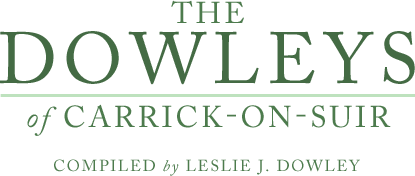

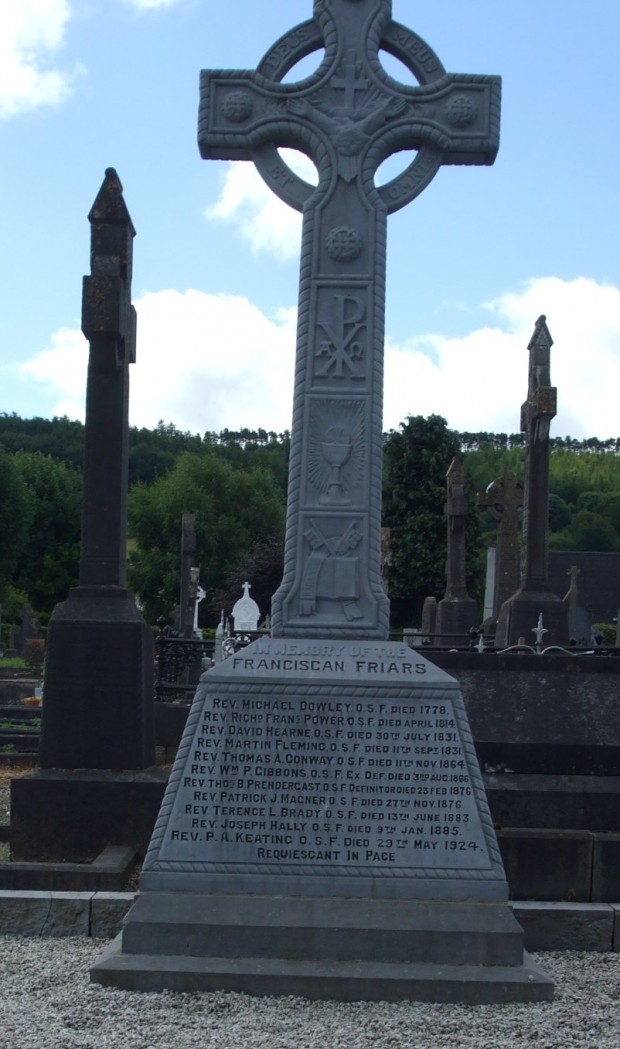
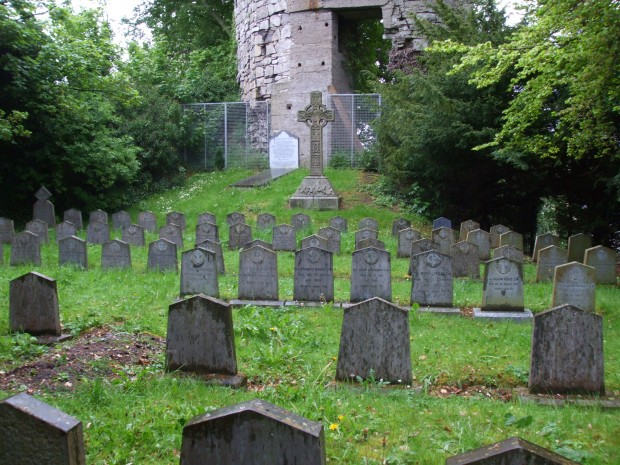
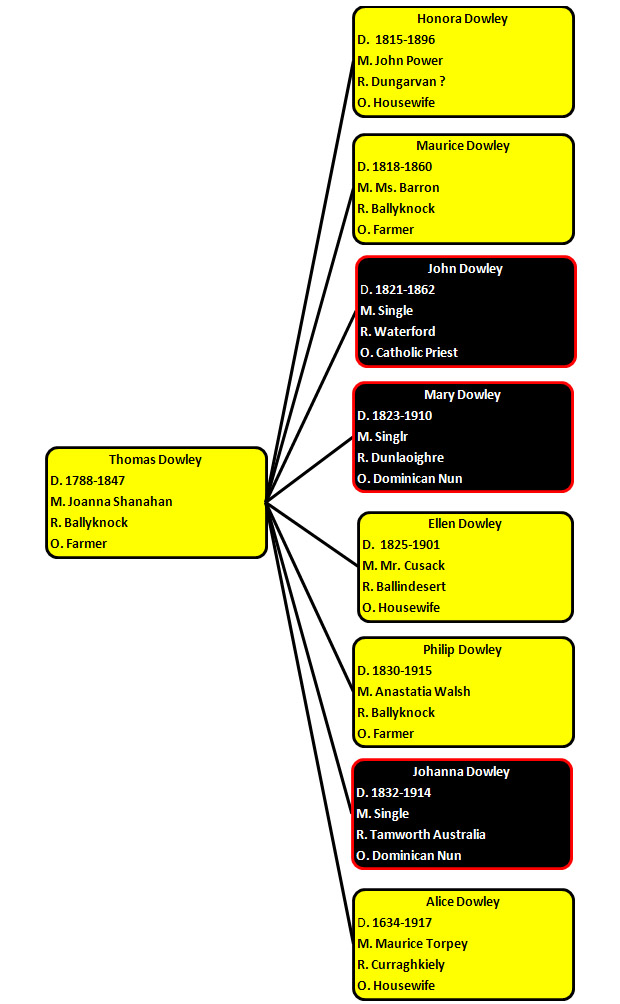
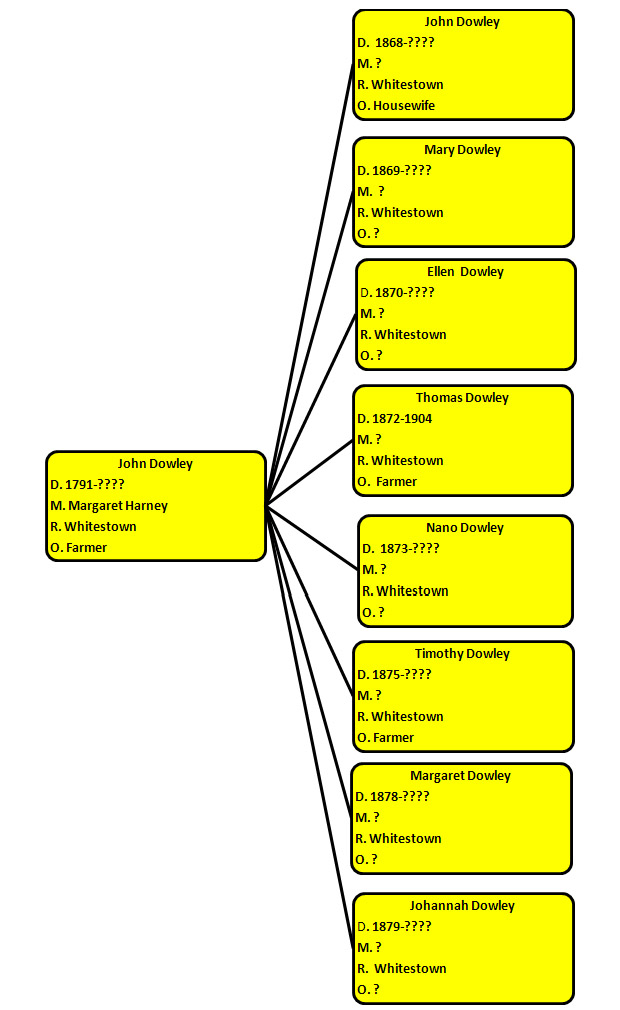
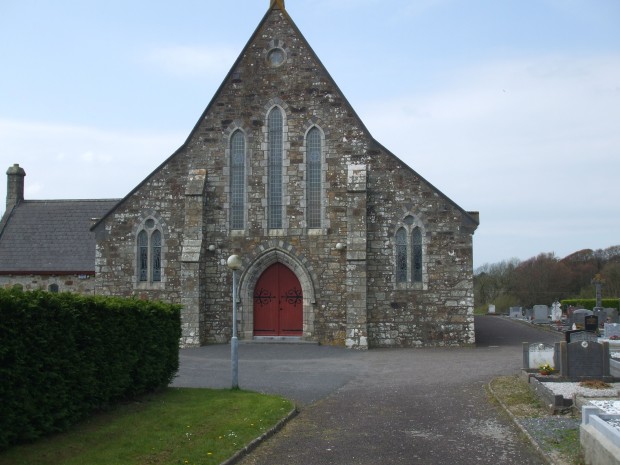
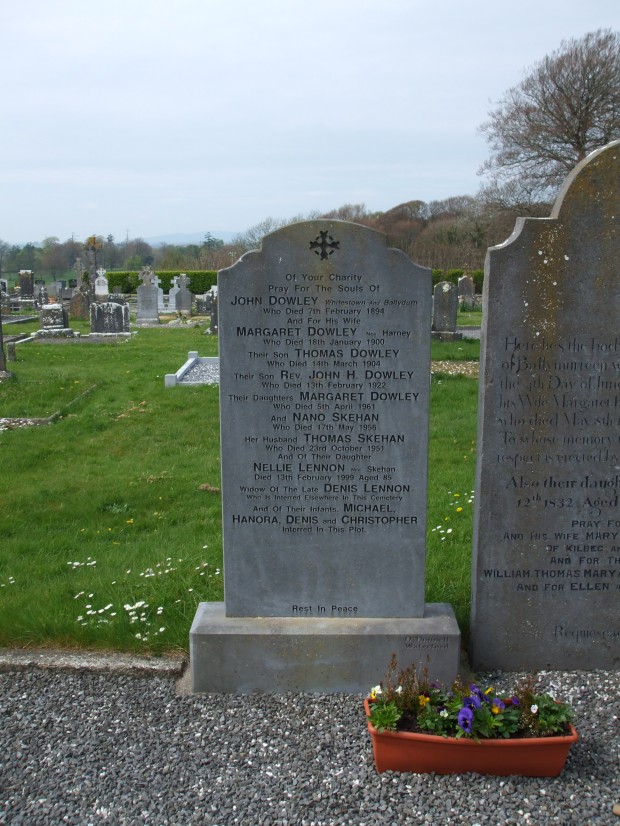
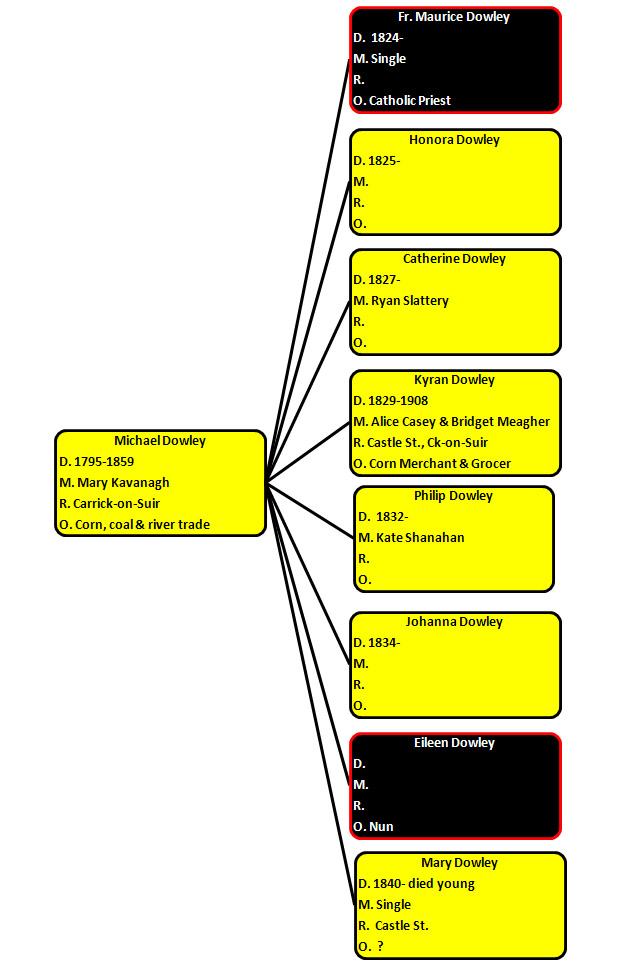
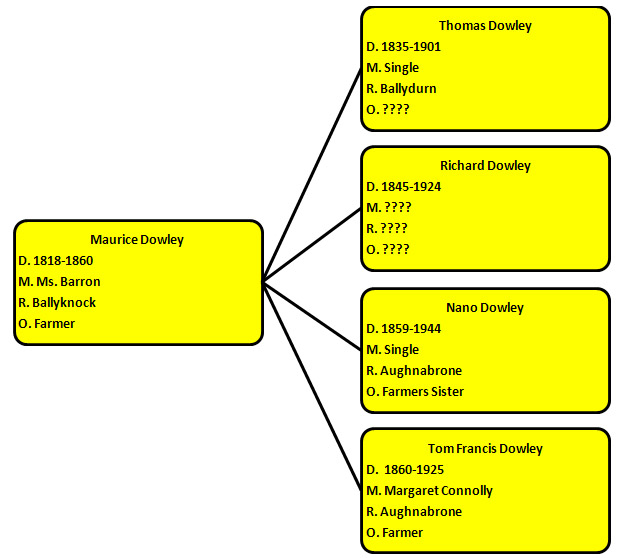
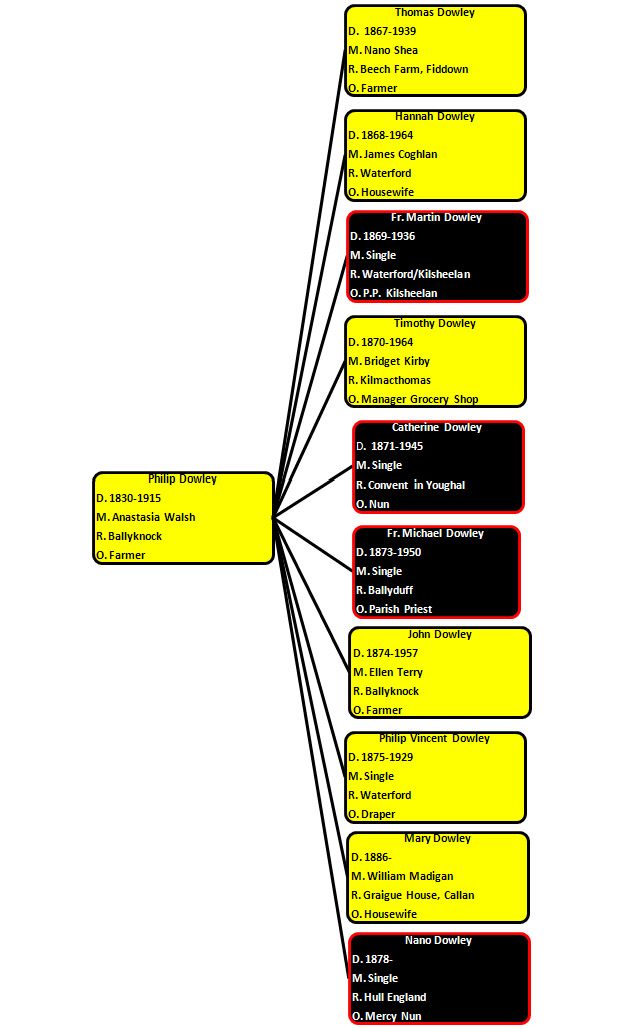
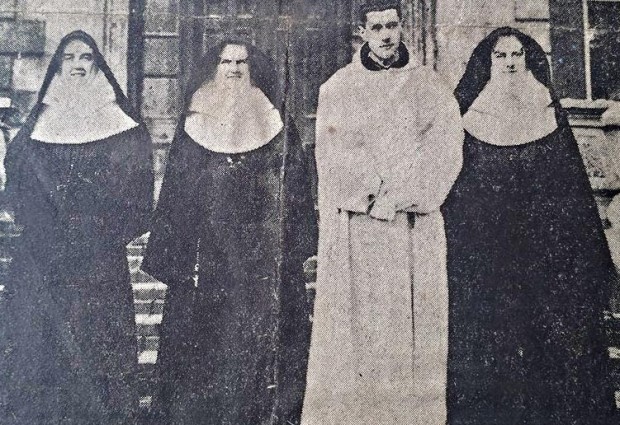
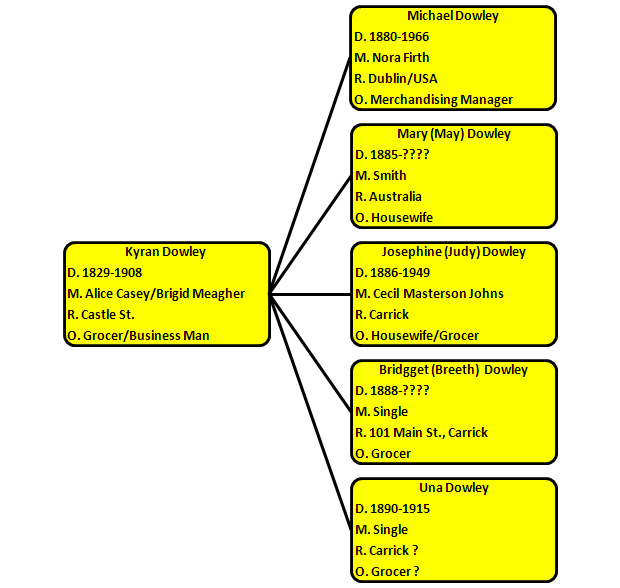

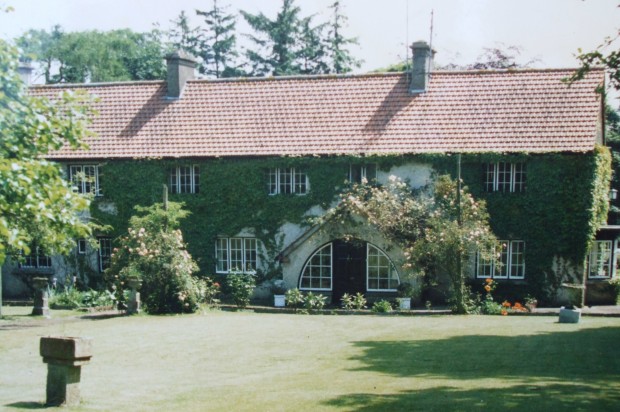
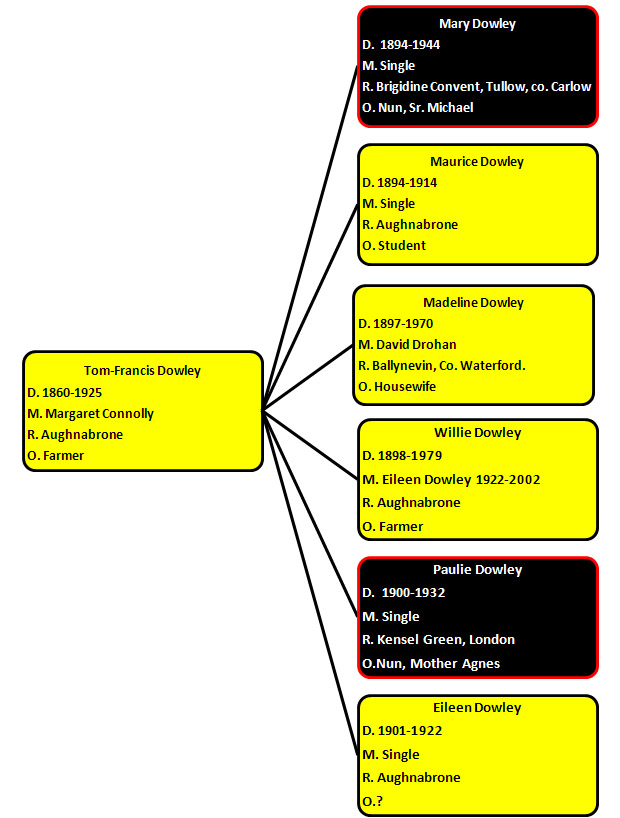
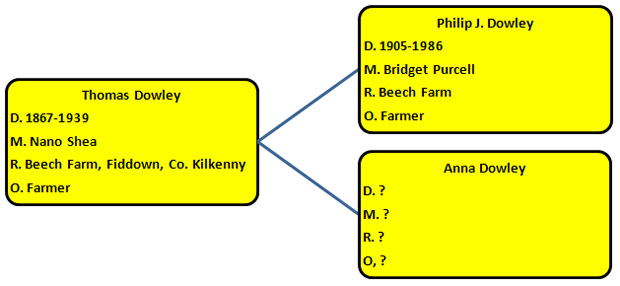
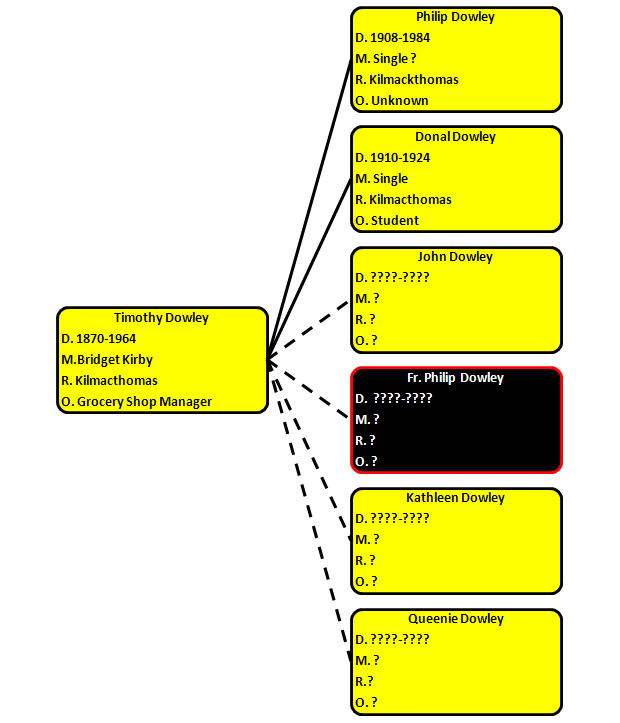
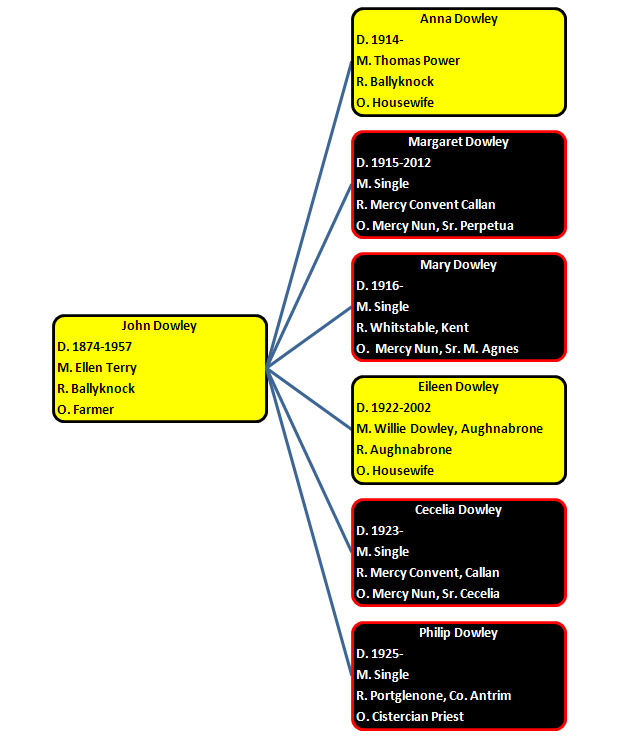
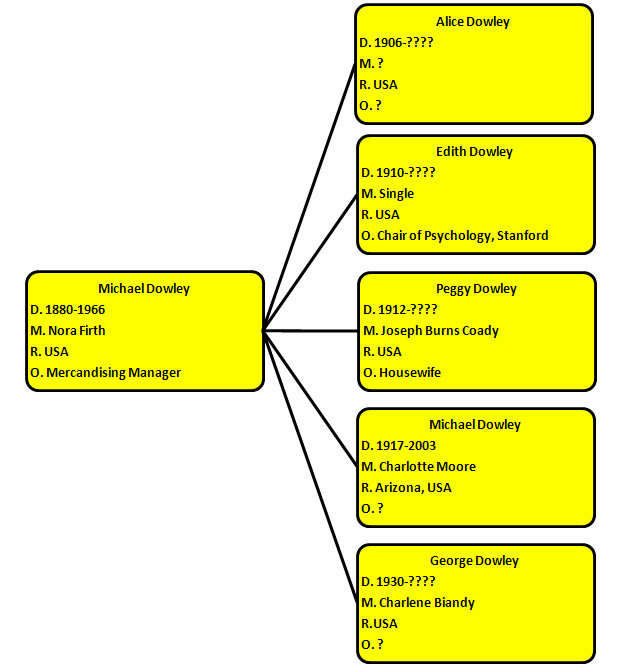

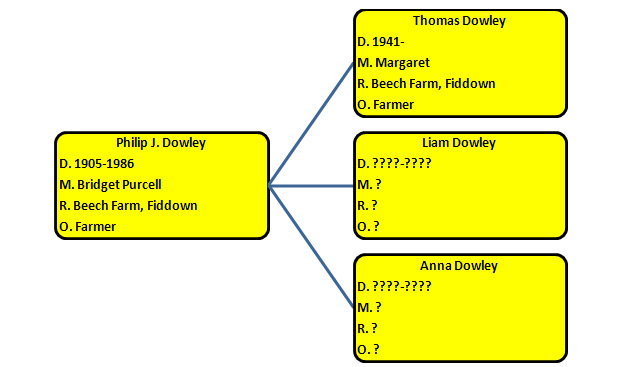
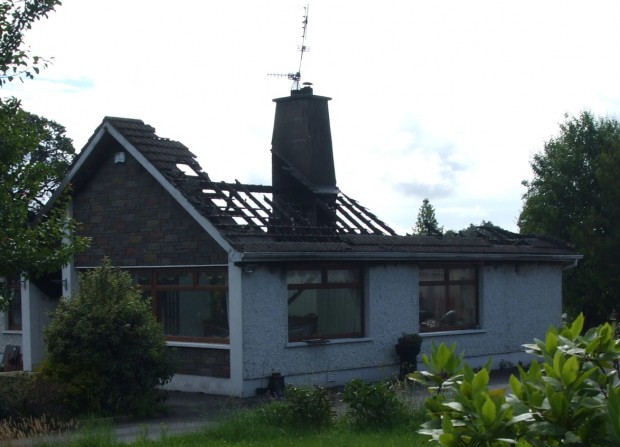
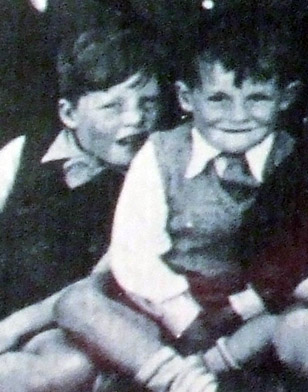
Your comments on my late mother’s Dowley history may or may not be apposite. Your characterisation of my mother in this section:
[…’ A very interesting, if somewhat inaccurate, account of the history of the Ballyknock Dowleys has been compiled by Mrs Betty Wilkinson of Australia who was a great-grand daughter of Michael Dowley and Mary Kavanagh. Her mother Mary (May) Dowley emigrated to Australia where she married a Mr. Smith. Betty Wilkinson (nee Smith) was the outcome of this marriage and as a result she was an Australian of Irish descent who probably had a romantic attachment to her Irish heritage and the Ballyknock Dowley family…’] is rubbish – a worthless and truly outstanding piece of boneheaded extrapolation.
My grandmother did not ’emigrate’ to Australia. She was an inveterate traveler and had gone to Australia to visit her uncle, Monsignor Peter Meagher. Traveling the world was much more of an adventure at the turn of the 19th century than it is now. On this visit, she met my grandfather and eventually married him, in Australia. My mother was born in 1914. My grandmother actually spent a large part of her life traveling around the world. After her marriage, she regularly returned to visit her family in Ireland; more often than not accompanied by my mother. My mother acquired the same taste for global travel. At the outbreak of the Second World War in 1939, she and her mother decided to go to Cairo, where my mother intended to become a VAD nurse. My father was a wartime officer of the Royal Deccan Horse, an Indian army cavalry regiment and he met my mother, in India when she was on this journey. By 1940, they were married and my mother lived in India until 1958, when my parents moved back to England. Although my mother paid several more visits to Australia, she did not actually live there after the age of 25, until she died at the age of 98. In her day, my late mother was a highly intelligent and sophisticated woman of the world. I have not read your putative Dolwey family ‘history’ for the following reasons. Your characterization of my mother as ‘an Australian of Irish descent who probably had a romantic attachment to her Irish heritage’ indicates two things. First of all that you believe my mother was incapable of understanding, accurately, her own family history. Secondly that, whether you are aware of it or not, you are a chauvinist who believes that all Australians are sentimental imbeciles, who can only think of their family history in ‘inaccurate’ terms. These two subjective traits of yours call into question the whole of your epic Dowley history. You should go through it again, with great care and try to be more objective, sticking to facts, from authentic sources and records; and when these are unclear, not substituting your interpretation of them, as if this was the fact. Perhaps then, your ‘history’ will actually become a history not a fairytale. Lets hope so.
Yours sincerely,
Martin Wilkinson.